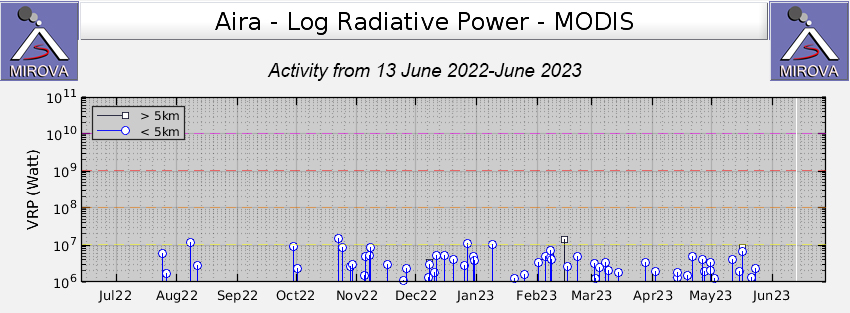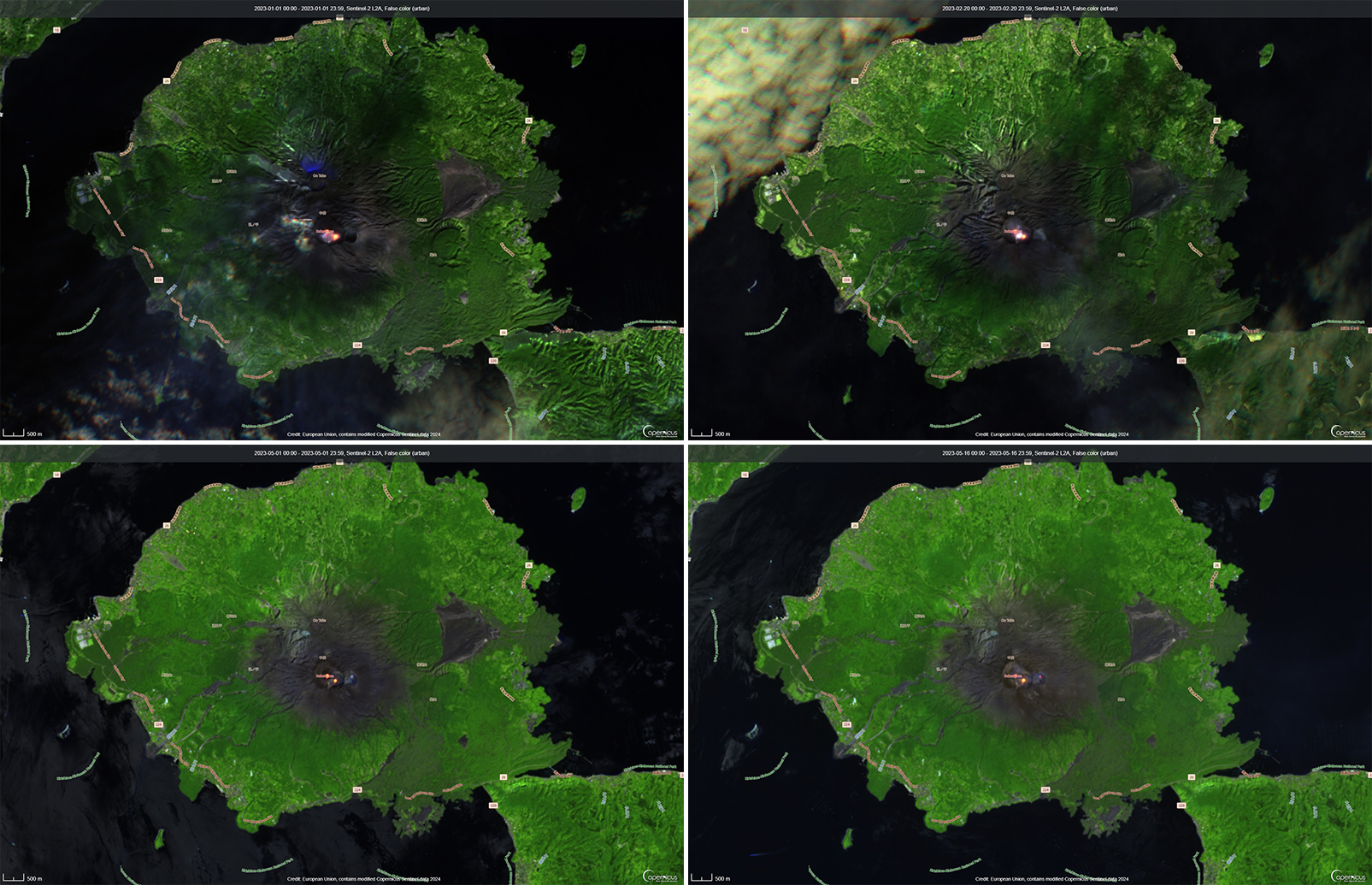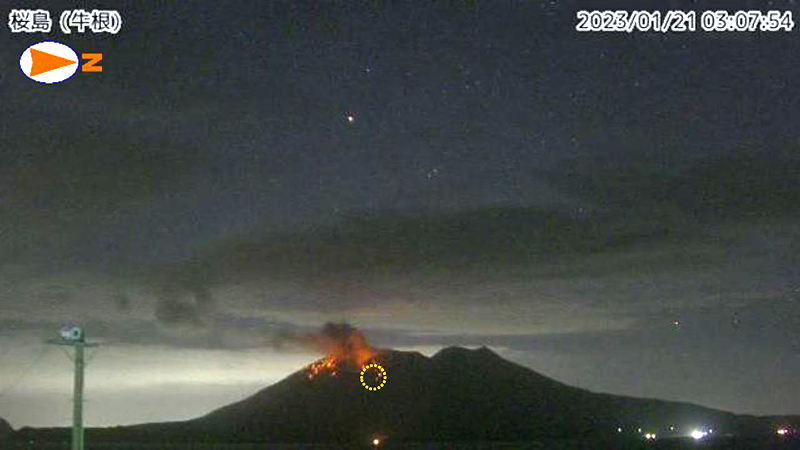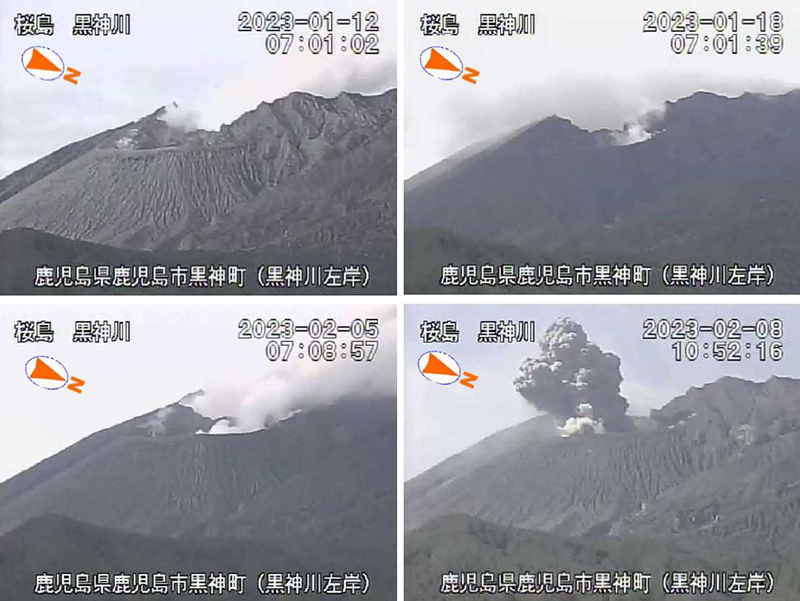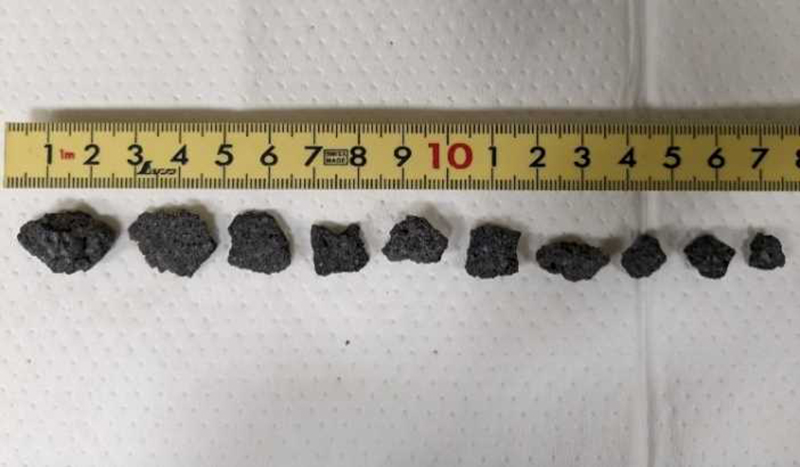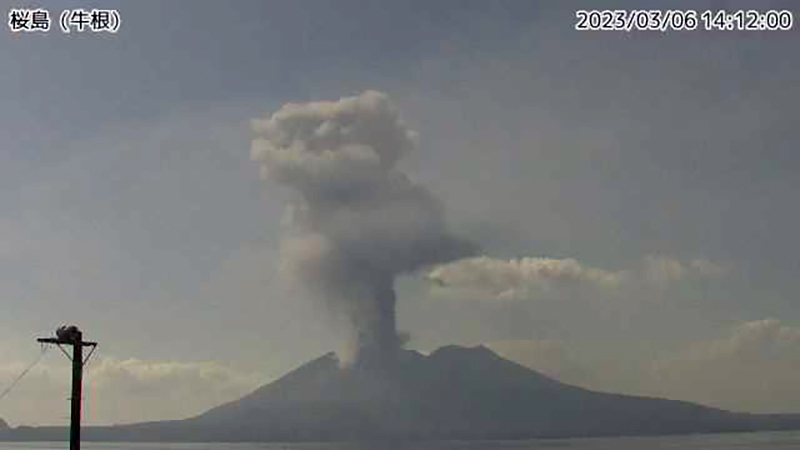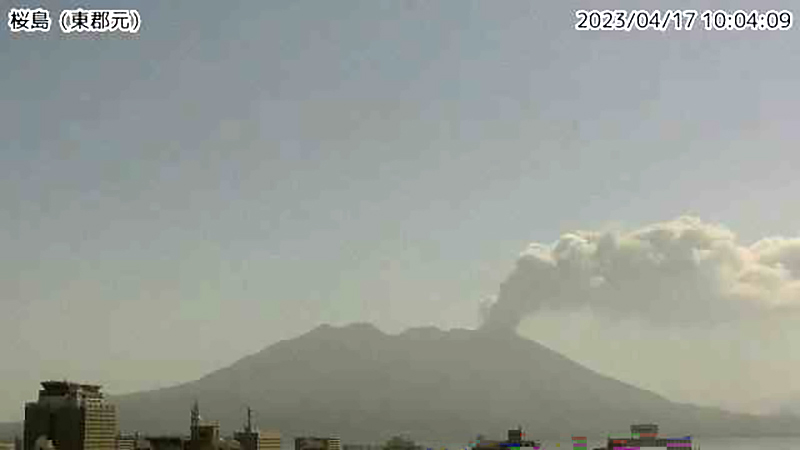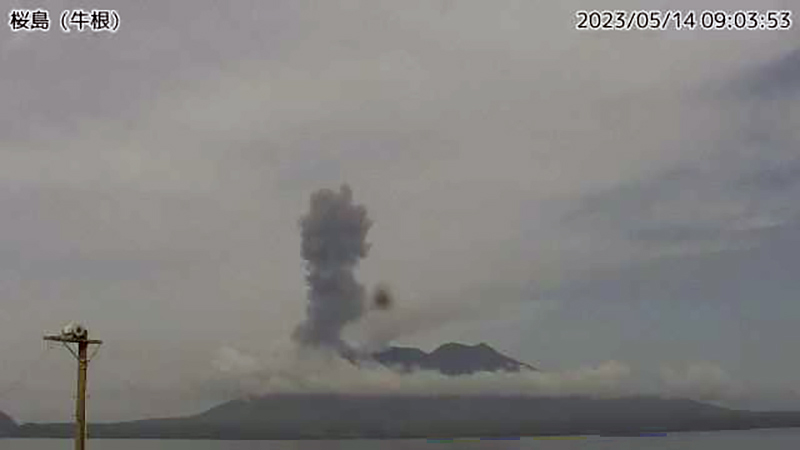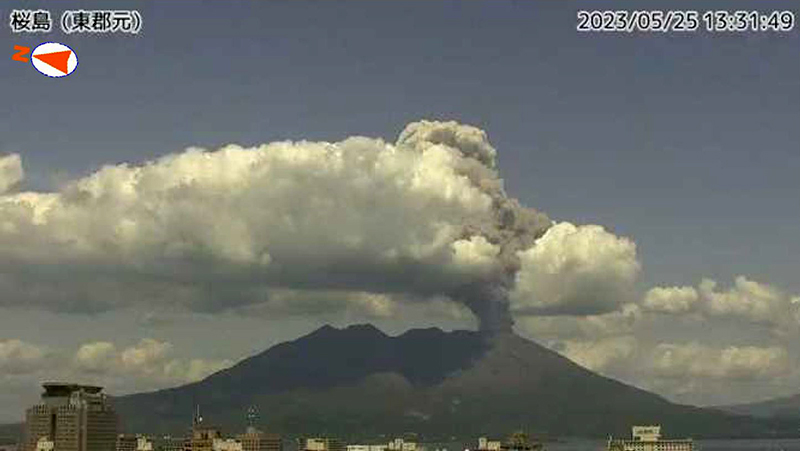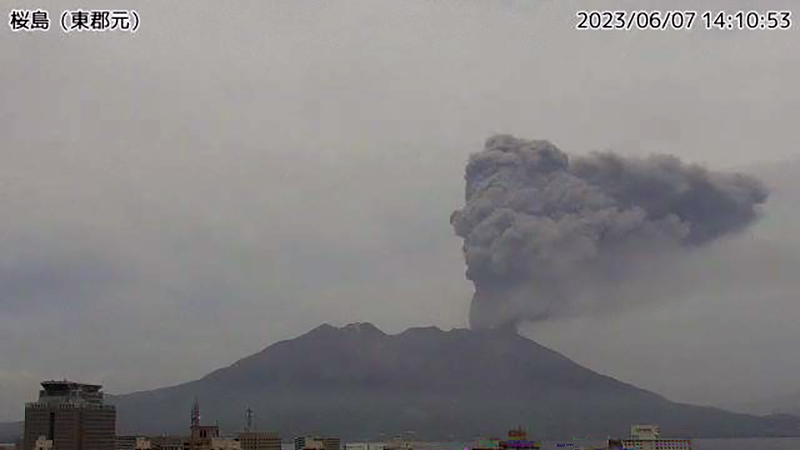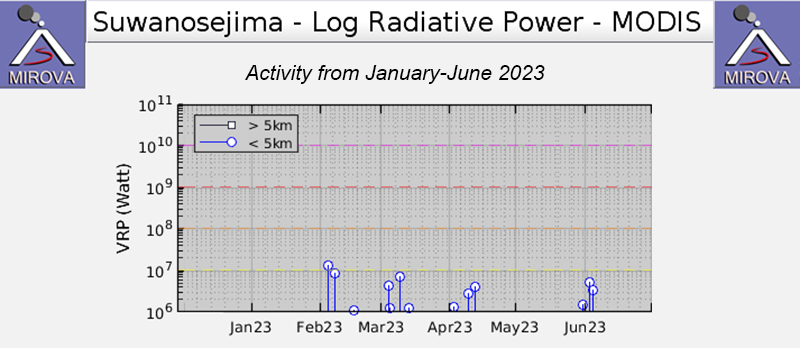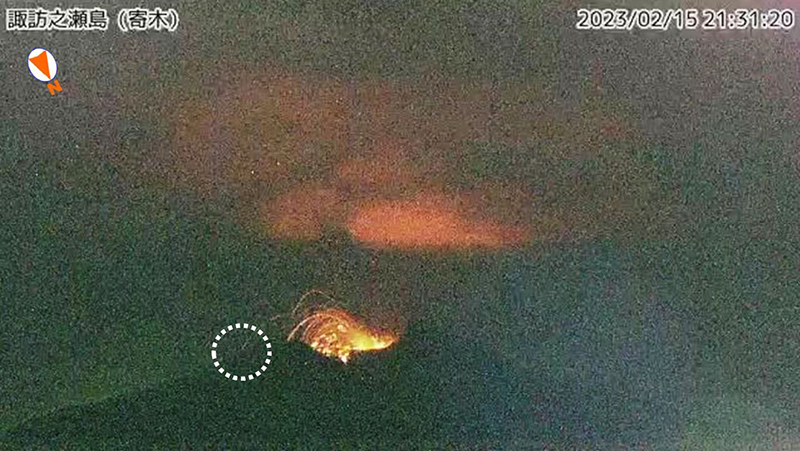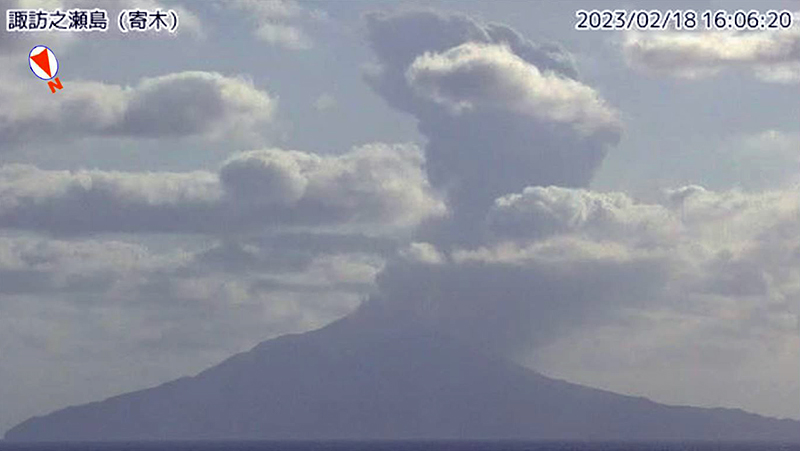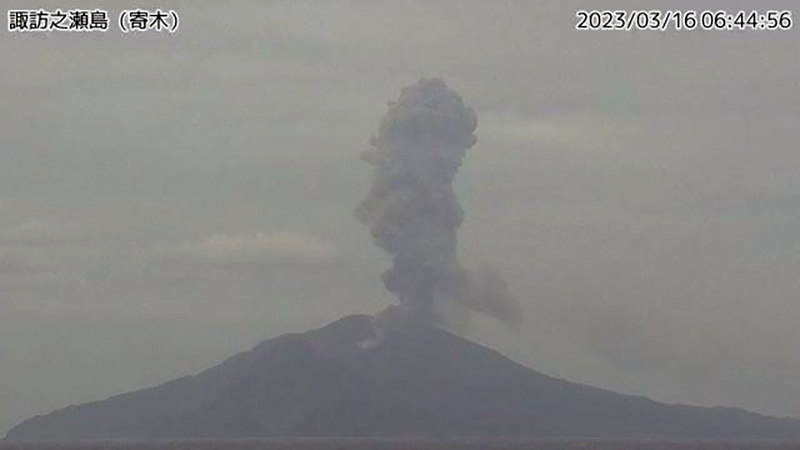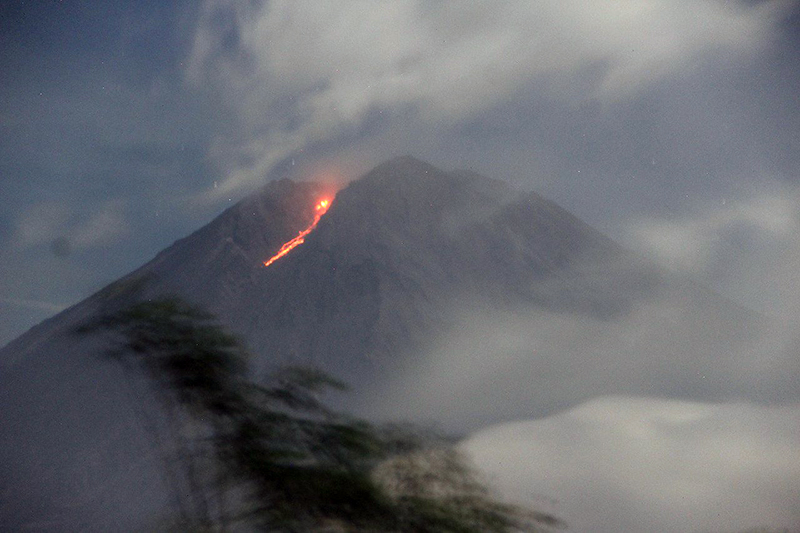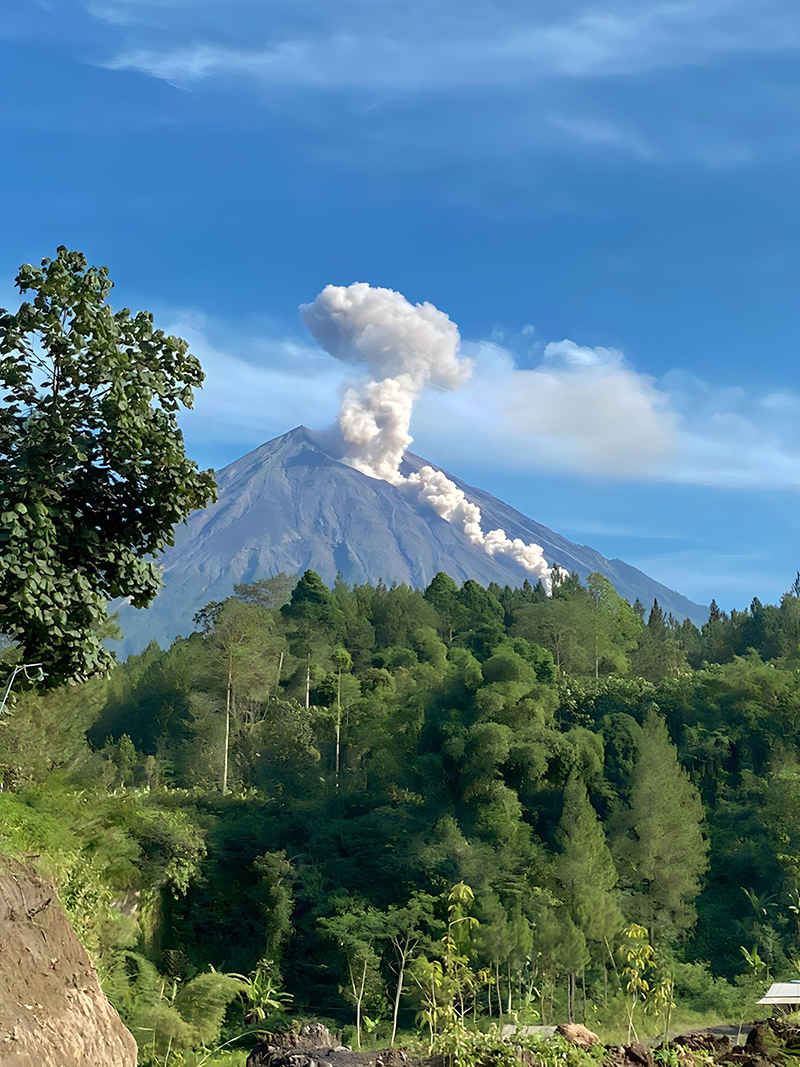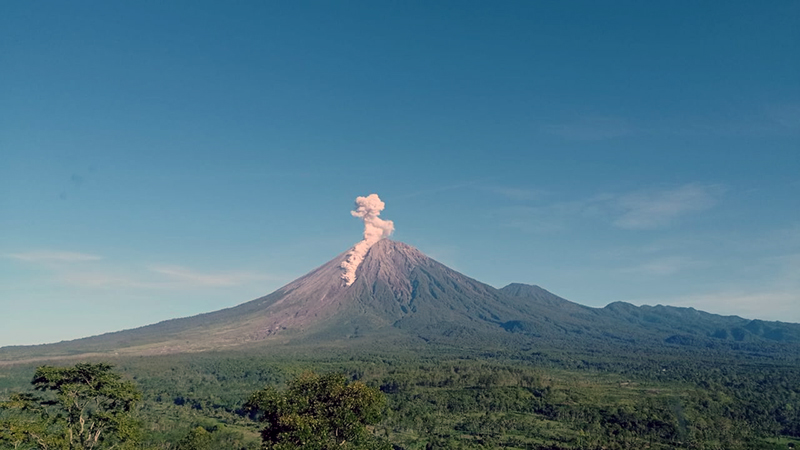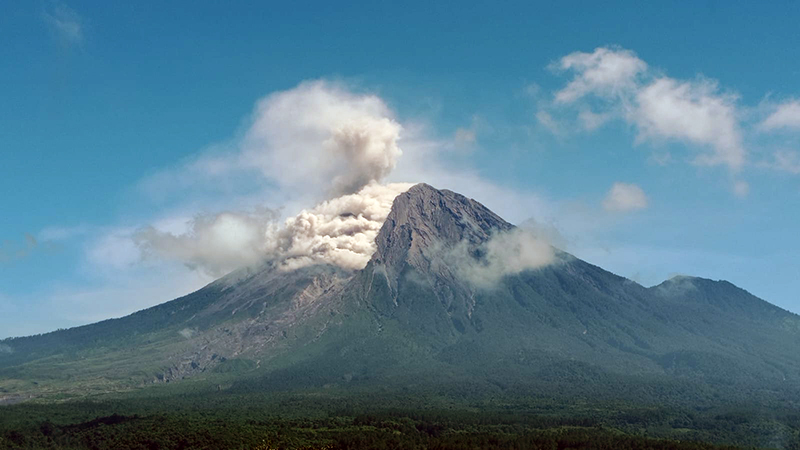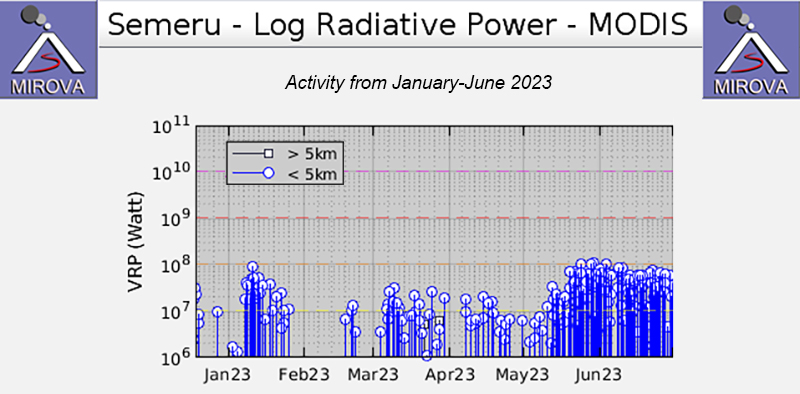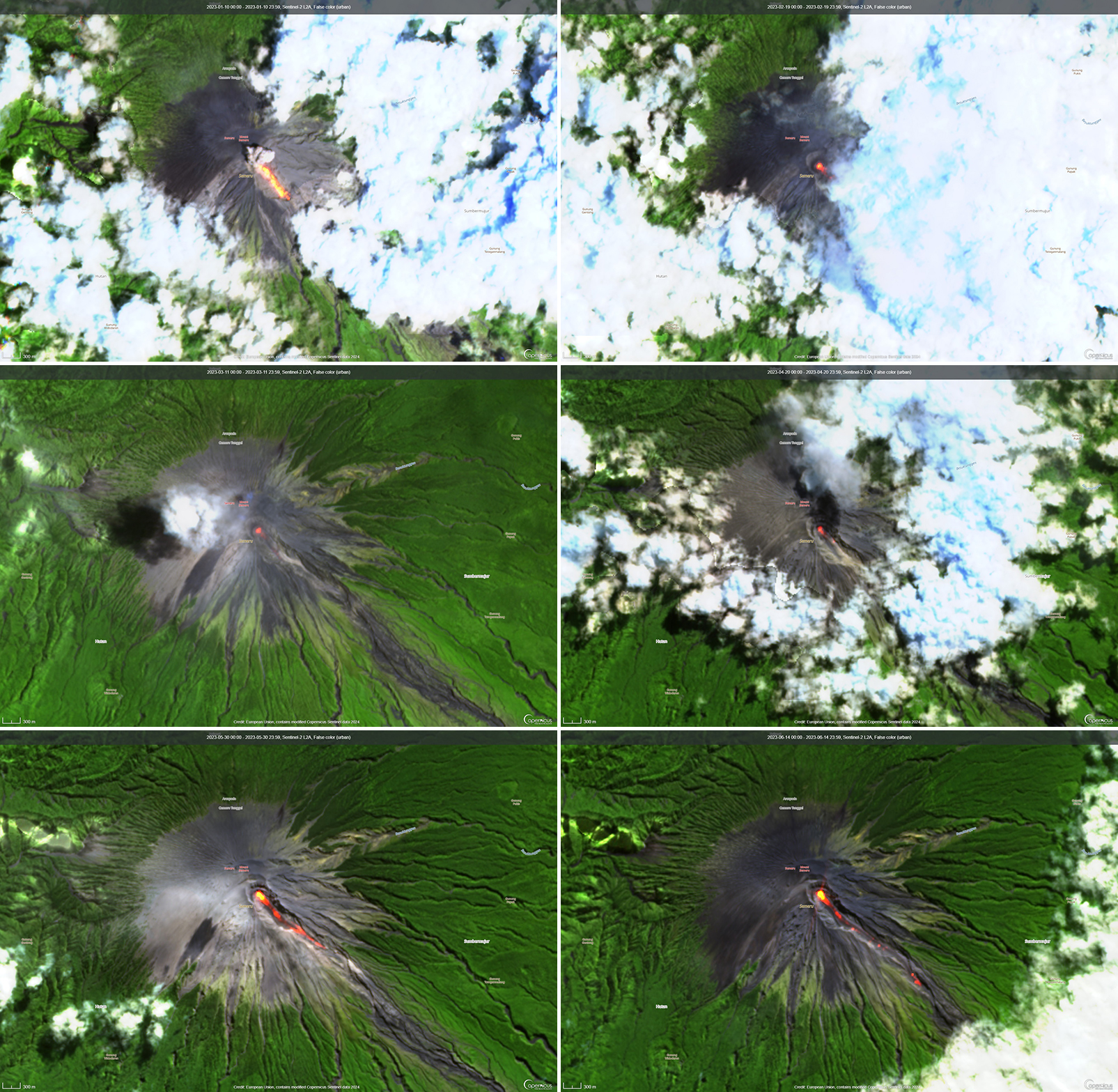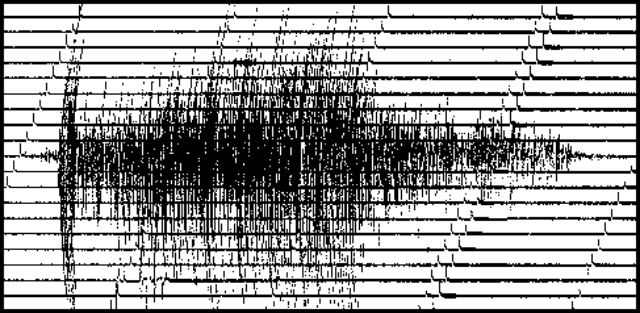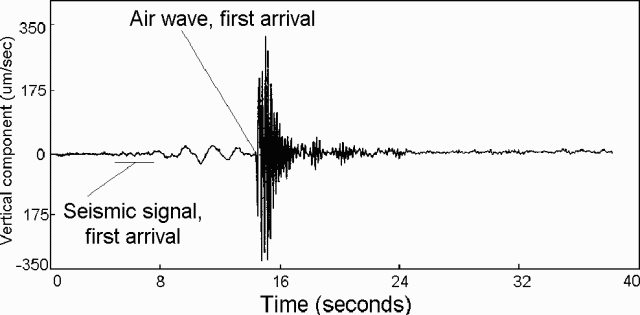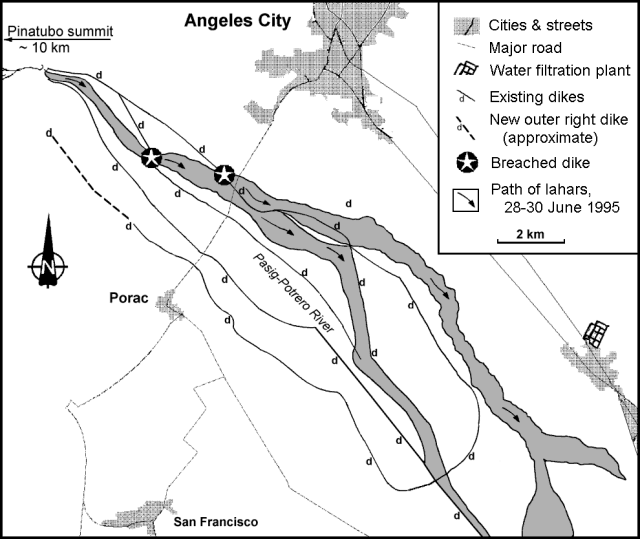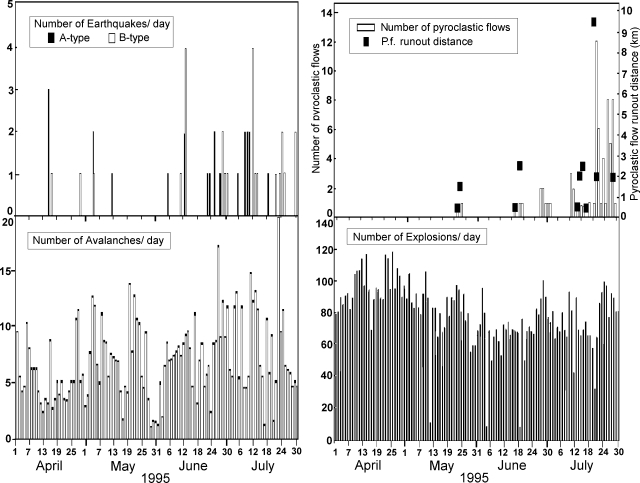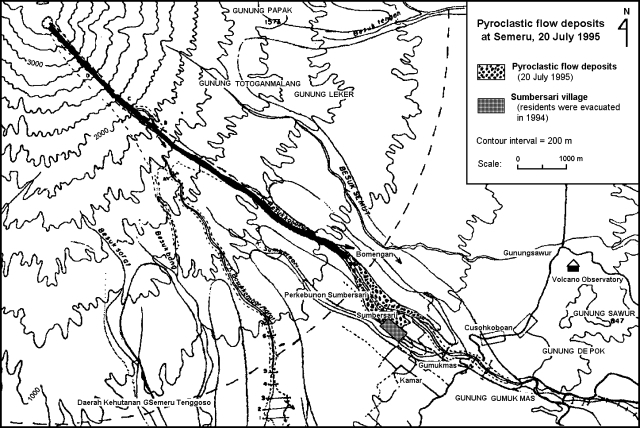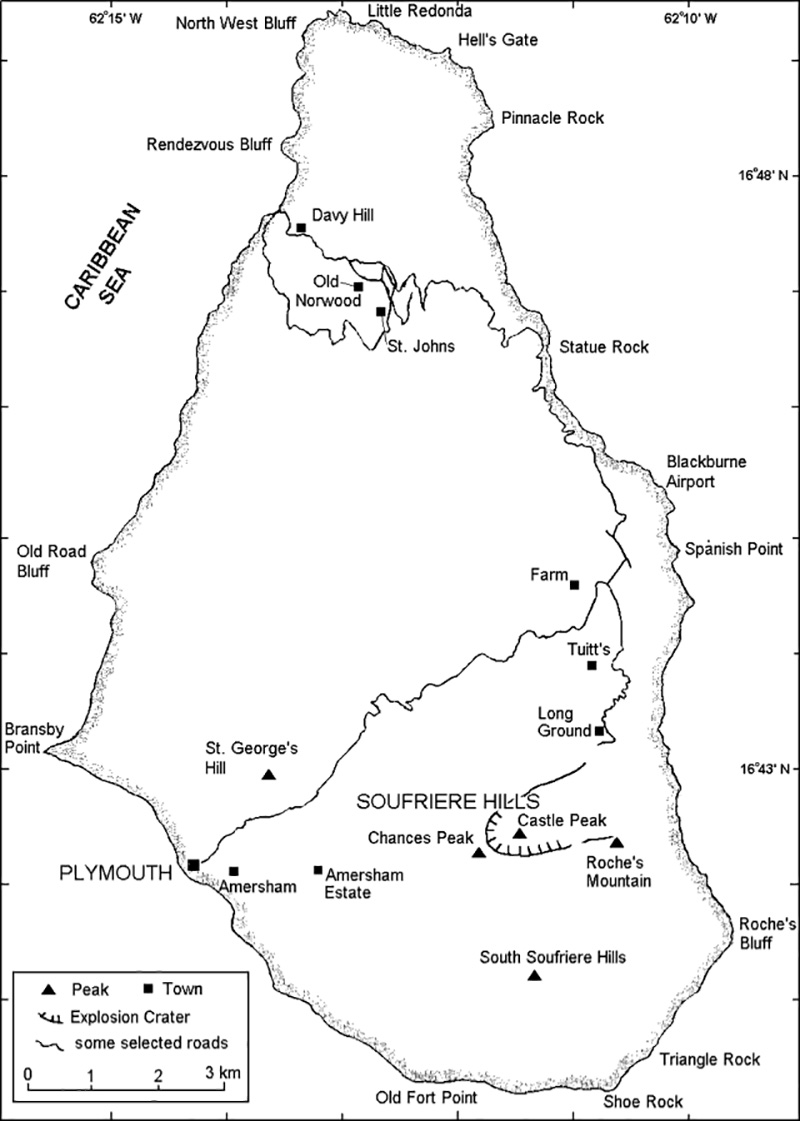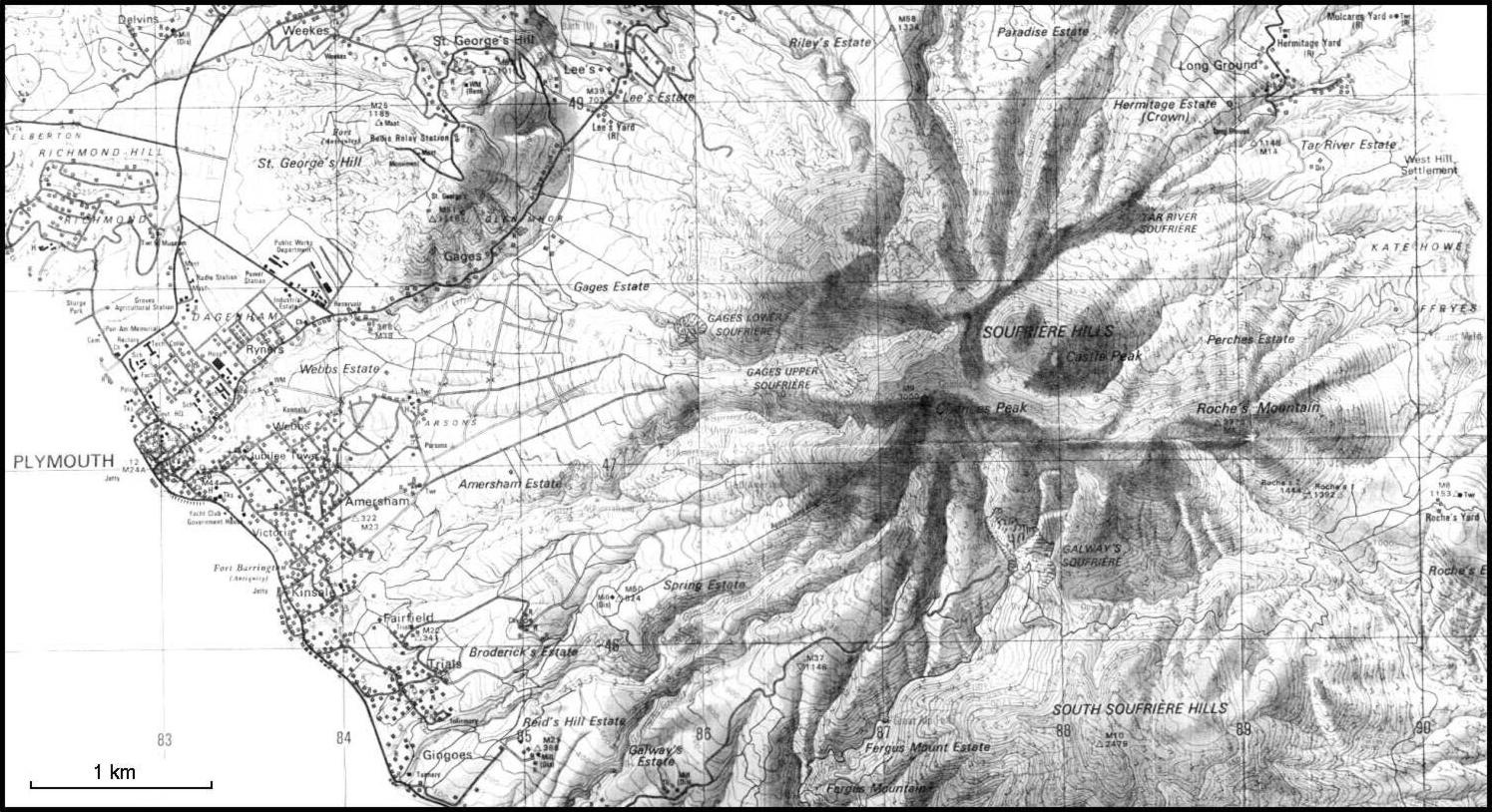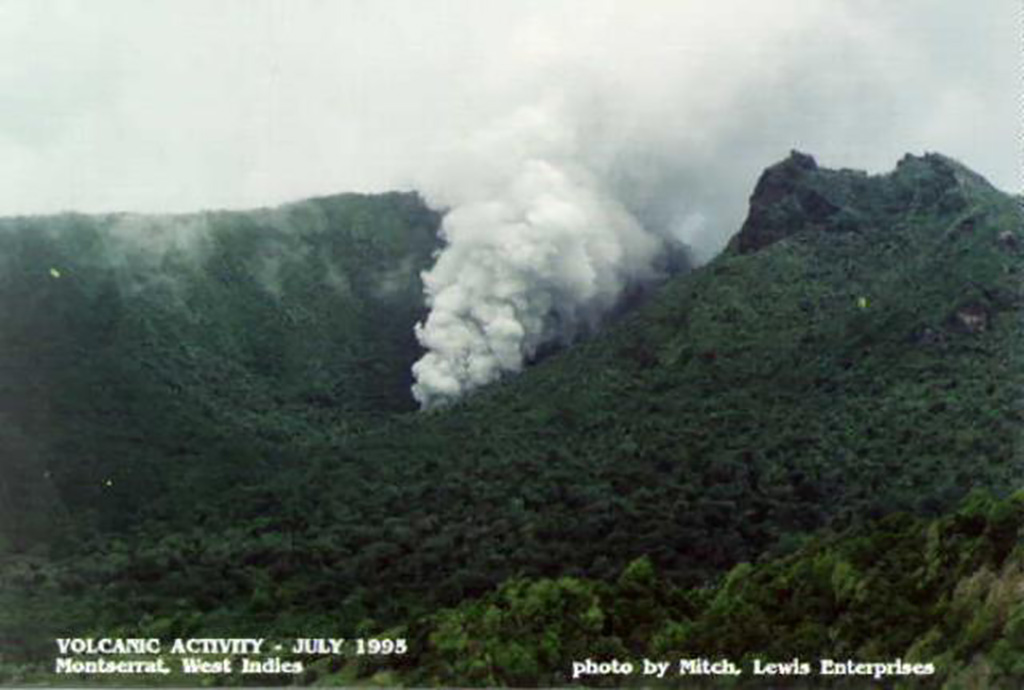Recently Published Bulletin Reports
Aira (Japan) Intermittent explosions, eruption plumes, and ashfall during January-June 2023
Suwanosejima (Japan) Frequent eruption plumes, explosions, and incandescent ejecta during January-June 2023
Semeru (Indonesia) Ash plumes, incandescent avalanches, and pyroclastic flows during January-June 2023
Manam (Papua New Guinea) Few ash plumes during November-December 2022
Krakatau (Indonesia) Strombolian activity and ash plumes during November 2022-April 2023
Stromboli (Italy) Strombolian explosions and lava flows continue during January-April 2023
Nishinoshima (Japan) Small ash plumes and fumarolic activity during November 2022 through April 2023
Karangetang (Indonesia) Lava flows, incandescent avalanches, and ash plumes during January-June 2023
Ahyi (United States) Intermittent hydroacoustic signals and discolored plumes during November 2022-June 2023
Kadovar (Papua New Guinea) An ash plume and weak thermal anomaly during May 2023
San Miguel (El Salvador) Small gas-and-ash explosions during March and May 2023
Semisopochnoi (United States) Occasional explosions, ash deposits, and gas-and-steam plumes during December 2022-May 2023
Aira
Japan
31.5772°N, 130.6589°E; summit elev. 1117 m
All times are local (unless otherwise noted)
Intermittent explosions, eruption plumes, and ashfall during January-June 2023
Aira caldera, located in the northern half of Kagoshima Bay, contains the active post-caldera Sakurajima volcano near the southern tip of Japan’s Kyushu Island. Eruptions date back to the 8th century and have deposited ash on Kagoshima, one of Kyushu’s largest cities, 10 km W from the summit. The Minamidake summit cone and crater has had persistent activity since 1955; the Showa crater on the E flank has also been intermittently active since 2006. The current eruption period began during late March 2017 and has more recently consisted of explosions, ash plumes, and ashfall (BGVN 48:01). This report covers activity during January through June 2023, characterized by intermittent explosions, eruption events, eruption plumes, and ashfall from both summit craters, according to monthly activity reports from the Japan Meteorological Agency (JMA) and satellite data.
Thermal activity remained at low levels during this reporting period; less than ten thermal anomalies were detected each month by the MIROVA (Middle InfraRed Observation of Volcanic Activity) system (figure 139). Occasional thermal anomalies were visible in infrared satellite images mainly at the Minamidake crater (Vent A is located to the left and Vent B is located to the right) and during May, in the Showa crater on the E flank (figure 140).
Table 29. Number of monthly explosive events, days of ashfall, area of ash covered, and sulfur dioxide emissions from Sakurajima’s Minamidake crater at Aira during January-June 2023. Note that smaller ash events are not listed. Ashfall days were measured at Kagoshima Local Meteorological Observatory, and ashfall amounts represent material covering all the Kagoshima Prefecture. Data courtesy of JMA monthly reports.
| Month |
Explosive events |
Days of ashfall |
Ashfall amount (g/m3) |
SO2 emissions (tons/day) |
| Jan 2023 |
9 |
2 |
2 |
1,000-2,800 |
| Feb 2023 |
11 |
7 |
6 |
1,900-3,500 |
| Mar 2023 |
8 |
6 |
9 |
2,100-3,500 |
| Apr 2023 |
0 |
4 |
3 |
1,800-2,700 |
| May 2023 |
10 |
13 |
10 |
1,800-3,900 |
| Jun 2023 |
2 |
8 |
3 |
1,400-1,900 |
JMA reported that during January 2023, there were 14 eruptions, nine of which were explosion events. Accompanying eruption plumes rose 2.4 km above the crater rim. Large blocks were ejected 800-1,100 m from the Minamidake crater. Nighttime incandescence was observed in the Minamidake crater using a high-sensitivity surveillance camera. No eruptions in the Showa crater were reported, though there was a gradual increase in the amount of white gas-and-steam emissions beginning around mid-January. Seismicity consisted of 121 volcanic earthquakes, which was higher than the 78 earthquakes in December. The Kagoshima Local Meteorological Observatory reported a total of 2 g/m2 of ashfall was observed over the course of two days of the month. According to field surveys, daily sulfur dioxide emissions ranged from 1,000-2,800 tons/day (t/d); emissions have remained at comparable, elevated, levels since July 2022. Explosions were reported on 3 January at 1615, 8 January at 0642 and 1955, 18 January at 1215, 19 January at 0659, 21 January at 0307, and 28 January at 2342 where eruption plumes rose 1-2.4 km above the Minamidake crater and drifted SE and S. The explosion at 0307 on 21 January generated an eruption plume 1.6 km above the crater rim and ejected large blocks 800-1,100 m from the crater rim; crater incandescence was also visible (figure 141). On 28 January at 2342 an explosion produced an eruption plume that rose 2-2.2 km above the Minamidake summit crater and drifted SE.
There were 26 eruptions reported during February, 11 of which were explosion events. Eruption plumes rose 2.4 km above the crater rim. Large blocks were ejected 800-1,100 m from the Minamidake summit crater, and daily nighttime crater incandescence continued. Occasional eruptive activity was observed in the Showa crater starting on 8 February, which included four eruptions (figure 142). The last time activity was reported in the Showa crater was early April 2018, according to JMA. There were 130 volcanic earthquakes detected during the month. Sulfur dioxide emissions ranged from 1,900-3,500 t/d. On 8 February large blocks were ejected 300-500 m from the Showa crater and an accompanying eruption plume rose 1.5 km above the crater rim. Summit crater incandescence was also visible at night during 8 and 21-26 February at the Showa crater. Weak crater incandescence was also reported on 8 February at the Minamidake summit crater. Explosions were recorded at 1815 on 9 February, at 1007 on 11 February, at 1448 on 14 February, at 0851 on 16 February, at 0206 on 19 February, at 2025 on 20 February, at 0937 and at 1322 on 21 February, and at 0558 on 28 February. Volcanic plumes rose 300-2,000 m above the Minamidake crater and drifted N, E, S, SE, and NE. An explosion at 1448 on 14 February at the Minamidake summit crater ejected large blocks 800-1,100 m from the crater. The eruption plume rose 800-1,200 m above the crater and drifted S. A field survey conducted on 14 February showed that the ejected volcanic clasts measured up to 3 cm in diameter, though most were smaller in size, and were deposited in Arimura, Kagoshima City (3 km SE) (figure 143). An aerial survey conducted by the Japan Maritime Self-Defense Force Air Group (JMSDF) on 21 February confirmed white gas-and-steam plumes rising from the N side of the Showa crater and water was visible at the bottom of the crater. Ashfall measurements showed that a total of 6 g/m2 fell over seven days during the month at the Kagoshima Local Metrological Observatory.
During March, 22 eruptions were reported, eight of which were explosion events. Volcanic plumes rose 2.8 km above the crater rim. There were four eruptions recorded at the Showa crater, for a total of eight eruptions during February and March. Large volcanic blocks were ejected 1,000-1,300 m from the Minamidake crater and nighttime incandescence remained visible at night, based on webcam images. Blocks ejected from the Showa crater traveled 500-800 m and accompanying eruption plumes rose 2.7 km above the crater rim. Nighttime crater incandescence was reported during 4-5 March at the Showa crater, based on webcam images. Seismicity included 97 volcanic earthquakes detected throughout the month. According to the Kagoshima Local Meteorological Observatory, a total of 9 g/m2 ashfall was observed over six days of the month. A field survey reported that 2,100-3,500 t/d of sulfur dioxide was released during the month. An eruption was detected at the Showa crater at 1404 on 6 March, that ejected blocks 500-800 m from the crater, accompanied by an eruption plume that rose 2.7 km above the crater rim (figure 144). Explosions were detected at 0116 on 3 March, at 2157 on 4 March, at 1322 on 8 March, at 2228 on 11 March, at 0418 on 14 March, and at 0035 on 22 March. Eruption plumes rose 1-2.8 km above the Minamidake crater and drifted SE, NE, NW, S, and SW. At 0035 on 22 March an explosion generated an eruption plume that rose 1.2 km above the Minamidake crater and drifted SW. Material was ejected 1-1.3 km from the Minamidake crater.
Two eruption events were reported in the Minamidake summit crater during April, neither of which were explosions; no eruptions occurred at the Showa crater. Eruption plumes rose 1.5 km above the crater rim and nighttime crater incandescence persisted nightly at the Minamidake crater. The number of volcanic earthquakes deceased to 38 and according to the Kagoshima Local Meteorological Observatory, a total of 3 g/m2 of ash fell over a period of four days during the month. The amount of sulfur dioxide released during the month ranged 1,800-2,700 t/d. An eruption event at 0955 on 17 April generated an eruption plume that rose 1.5 km above the crater rim (figure 145).
Eruptive activity during May consisted of 17 eruptions, 10 of which were explosion events. Volcanic plumes rose 2.3 km above the crater rim and large ejecta traveled 800-1,100 m from the Minamidake summit crater. Activity at the Showa crater was characterized by 11 eruption events and material was ejected 300-500 m from the crater. Nighttime crater incandescence was observed at both summit craters. The number of monthly volcanic earthquakes increased to 88 and the amount of ashfall recorded was 10 g/m2 over a period of 13 days during the month. According to a field survey, the amount of sulfur dioxide released ranged 1,800-3,900 t/d.
Explosions were recorded at 0422 on 2 May, at 0241 and at 1025 on 3 May, at 1315 on 9 May, at 2027 on 17 May, at 0610 on 24 May, at 1327 on 25 May, at 0647 and 1441 on 26 May, and at 1520 on 28 May. Resulting eruption plumes rose 400-1,800 m above the Minamidake crater and drifted SW, W, and N. On 14 May an eruption plume was visible above the Showa crater at 0859 that rose 1.7 km above the crater rim (figure 146). An eruption event at the Minamidake summit crater occurred at 1327 on 25 May; the eruption plume rose 2.3 km above the crater rim (figure 147).
JMA reported four eruptions occurred during June, two of which were explosion events. Eruption plumes rose as high as 2.5 km above the Minamidake crater rim and large volcanic blocks were ejected 500-700 m from the crater rim. At the Showa crater, seven eruptions occurred, one of which was an explosion event. Eruption plumes rose 1.5 km above the Showa crater rim and large material was ejected 500 m from the crater rim. Nighttime incandescence was reported for both summit craters. There were 73 volcanic earthquakes detected during the month and a total of 3 g/m2 of ashfall during eight days of the month. According to a field survey, the amount of sulfur dioxide emissions released ranged 1,400-1,900 t/d. On 5 June at 0012 an explosion generated an eruption plume that rose 400-1,000 m above the Minamidake crater and drifted SE. An explosion at the Minamidake crater occurred at 1401 on 7 June that generated an eruption plume that rose 2.5 km above the crater and drifted SE (figure 148). A single explosion was reported at the Showa crater at 0438 on 22 June. The eruption plume rose 600 m above the crater rim and large blocks were ejected 500 m from the crater rim. This is the first report of an explosion at the Showa crater since October 2017, according to JMA.
Geologic Background. The Aira caldera in the northern half of Kagoshima Bay contains the post-caldera Sakurajima volcano, one of Japan's most active. Eruption of the voluminous Ito pyroclastic flow accompanied formation of the 17 x 23 km caldera about 22,000 years ago. The smaller Wakamiko caldera was formed during the early Holocene in the NE corner of the caldera, along with several post-caldera cones. The construction of Sakurajima began about 13,000 years ago on the southern rim and built an island that was joined to the Osumi Peninsula during the major explosive and effusive eruption of 1914. Activity at the Kitadake summit cone ended about 4,850 years ago, after which eruptions took place at Minamidake. Frequent eruptions since the 8th century have deposited ash on the city of Kagoshima, located across Kagoshima Bay only 8 km from the summit. The largest recorded eruption took place during 1471-76.
Information Contacts: Japan Meteorological Agency (JMA), 1-3-4 Otemachi, Chiyoda-ku, Tokyo 100-8122, Japan (URL: http://www.jma.go.jp/jma/indexe.html); MIROVA (Middle InfraRed Observation of Volcanic Activity), a collaborative project between the Universities of Turin and Florence (Italy) supported by the Centre for Volcanic Risk of the Italian Civil Protection Department (URL: http://www.mirovaweb.it/); Copernicus Browser, Copernicus Data Space Ecosystem, European Space Agency (URL: https://dataspace.copernicus.eu/browser/).
Suwanosejima (Japan) — July 2023  Cite this Report
Cite this Report
Suwanosejima
Japan
29.638°N, 129.714°E; summit elev. 796 m
All times are local (unless otherwise noted)
Frequent eruption plumes, explosions, and incandescent ejecta during January-June 2023
Suwanosejima is located in the northern Ryukyu Islands, Japan, and is an 8-km-long island that consists of a stratovolcano and two active summit craters. Volcanism during the 20th century is characterized by Strombolian explosions, ash plumes, and ashfall. The current eruption began in October 2004 and has more recently consisted of intermittent explosions, eruption plumes, ashfall, and incandescent ejecta (BGVN 48:01). Similar activity continued during this reporting period of January through June 2023, based on monthly report from the Japan Meteorological Agency (JMA) and satellite data.
The MIROVA (Middle InfraRed Observation of Volcanic Activity) Log Radiative Power graph of the MODIS thermal anomaly data showed low thermal activity throughout the reporting period (figure 76). Three anomalies were detected during February, four during March, three during April, one during late May, and two during early June. A single thermal hotspot was detected by the MODVOLC thermal alerts system on the NE flank on 7 February. There were only two clear weather days in infrared satellite imagery that showed a thermal anomaly on 7 March and 5 June (figure 77).
Activity in the Otake crater during January 2023 was relatively low, which prompted JMA to lower the Volcano Alert Level (VAL) from 3 to 2 (on a 5-level scale) on 24 January. The number of explosions recorded during the month was 13. There were 50 volcanic earthquakes detected on the W side of the island, which was roughly comparable to December (44), although near the Otake crater, there were 188 earthquakes recorded, which excluded earthquakes associated with explosions. An aerial overflight conducted on 11 January by the Japan Maritime Self-Defense Force Air Group (JMSDF) reported a gray-white plume rising from the Otake crater. During 26-30 January there was a brief increase in the number of explosions. An eruption at 0331 on 26 January generated an eruption plume that rose 1.7 km above the crater rim and ejected large blocks 400 m S from the crater. Nighttime crater incandescence was visible in a highly sensitive surveillance camera starting on 26 January. According to the Toshima Village Office, Suwanosejima Branch Office, ashfall was occasionally observed in the village (3.5 km SSW). According to observations conducted by the University of Tokyo Graduate School of Science, Kyoto University Disaster Prevention Research Institute, Toshima Village, and JMA, the amount of sulfur dioxide emissions released during the month was 200-600 tons per day (t/d).
Eruptive activity in the Otake crater continued during February; the total number of explosions increased during this month from 13 to 56. There were 119 volcanic earthquakes detected on the W side of the island and 449 near the Otake crater, excluding earthquakes associated with explosions. During 15-21 February there was a brief increase in the number of explosions, and large blocks were ejected as far as 1 km from the crater. An explosion at 2131 on 15 March ejected material 900 m SE (figure 78). Eruptions on 18 and 27 February generated plumes that rose 2 km above the crater (figure 79). By 21 February the number of explosions reached 42, though no large-scale volcanic earthquakes were reported. Nighttime crater incandescence continued from late January through February. Ashfall was also occasionally observed in Toshima Village. The amount of sulfur dioxide emissions released during the month was 700 t/d.
The number of explosions at the Otake crater increased during 2-5 March; 28 explosions were detected during this time. Large volcanic blocks were ejected 500 m from the crater. As a result, the VAL was increased to 3 on 5 March. There were 65 explosions recorded throughout the month. On the W side of the island, 63 volcanic earthquakes were reported, and closer to the Otake crater, 422 were detected, excluding earthquakes associated with explosions. Nighttime crater incandescence continued, as well as occasional ashfall in Toshima Village. On 16 March an eruption produced a volcanic plume that rose 2.4 km above the crater rim (figure 80). The amount of sulfur dioxide emissions released during the month was 200-1,100 t/d.
Eruptive activity continued at the Otake crater during April. Eruption plumes rose as high as 2 km above the crater rim and large blocks were ejected as far as 500 m from the crater. The number of explosions decreased to one throughout the month, although nighttime crater incandescence remained visible in the surveillance camera. Rumbling and ashfall continued intermittently in Toshima Village. There were 32 volcanic earthquakes detected, and 129 volcanic earthquakes near the Otake crater, not including those associated with explosions. According to JMA, the amount of sulfur dioxide released during the month was 200-1,400 t/d. On 16 April at 0402 an eruption ejected incandescent material 500 m S from the crater.
Activity continued at the Otake crater in May. An eruption plume rose 1.8 km above the crater rim and large volcanic blocks were ejected 300 m from the crater. The number of explosions remained low throughout the month (7) and nighttime crater incandescence persisted. Occasional ashfall was reported in Toshima Village. As many as 44 volcanic earthquakes were recorded on the W side of the island, and 205 were recorded closer to the Otake crater, which was higher compared to the previous month. Generally, the amount of sulfur dioxide released during the month ranged 400-700 t/d, but on 19 May the amount increased to 2,600 t/d. On 16 May an eruption produced a volcanic plume that rose 1.8 km above the crater rim.
Eruptive activity was relatively low in June; the number of explosions generally decreased and on 9 June the VAL was lowered to 2. Nighttime crater incandescence continued, and according to the Toshima Village Office, rumbling and ashfall were also noted occasionally. There were 31 explosions throughout the month and 28 volcanic earthquakes detected on the W side of the island and as many as 722 volcanic earthquakes were recorded near the Otake crater. During 13-19 June, JMA reported a brief increase in the number of explosions. On 15 June at 2200 an eruption generated a volcanic plume that rose 2 km above the crater rim. An eruption on 16 June at 2147 ejected material 400 m SE from the crater. The amount of sulfur dioxide emitted was relatively low, at 100 t/d on 27 June.
Geologic Background. The 8-km-long island of Suwanosejima in the northern Ryukyu Islands consists of an andesitic stratovolcano with two active summit craters. The summit is truncated by a large breached crater extending to the sea on the E flank that was formed by edifice collapse. One of Japan's most frequently active volcanoes, it was in a state of intermittent Strombolian activity from Otake, the NE summit crater, between 1949 and 1996, after which periods of inactivity lengthened. The largest recorded eruption took place in 1813-14, when thick scoria deposits covered residential areas, and the SW crater produced two lava flows that reached the western coast. At the end of the eruption the summit of Otake collapsed, forming a large debris avalanche and creating an open collapse scarp extending to the eastern coast. The island remained uninhabited for about 70 years after the 1813-1814 eruption. Lava flows reached the eastern coast of the island in 1884. Only about 50 people live on the island.
Information Contacts: Japan Meteorological Agency (JMA), 1-3-4 Otemachi, Chiyoda-ku, Tokyo 100-8122, Japan (URL: http://www.jma.go.jp/jma/indexe.html); MIROVA (Middle InfraRed Observation of Volcanic Activity), a collaborative project between the Universities of Turin and Florence (Italy) supported by the Centre for Volcanic Risk of the Italian Civil Protection Department (URL: http://www.mirovaweb.it/); Hawai'i Institute of Geophysics and Planetology (HIGP) - MODVOLC Thermal Alerts System, School of Ocean and Earth Science and Technology (SOEST), Univ. of Hawai'i, 2525 Correa Road, Honolulu, HI 96822, USA (URL: http://modis.higp.hawaii.edu/); Copernicus Browser, Copernicus Data Space Ecosystem, European Space Agency (URL: https://dataspace.copernicus.eu/browser/).
Semeru
Indonesia
8.108°S, 112.922°E; summit elev. 3657 m
All times are local (unless otherwise noted)
Ash plumes, incandescent avalanches, and pyroclastic flows during January-June 2023
Semeru contains the active Jonggring-Seloko vent at the Mahameru summit and is located in East Java, Indonesia. Frequent 19th and 20th century eruptions were dominated by small-to-moderate explosions from the summit crater, with occasional lava flows and larger explosive eruptions accompanied by pyroclastic flows that have reached the lower flanks of the volcano. The current eruption began in June 2017 and more recently has been characterized by intermittent gas-and-ash plumes and incandescent avalanches (BGVN 48:01). This report updates activity such as ash plumes, incandescent avalanches, and pyroclastic flows from January through June 2023, based on information from daily, VONA, and special reports from the Pusat Vulkanologi dan Mitigasi Bencana Geologi (PVMBG, also known as Indonesian Center for Volcanology and Geological Hazard Mitigation, CVGHM), MAGMA Indonesia, and various satellite data.
Activity during January and February mainly consisted of frequent ash plumes and white-and-gray emissions. The ash plumes during January rose 200-1,000 m above the crater and drifted in different directions. The white-and-gray emissions rose 200-1,000 m above the crater. A photo was posted on social media that showed an incandescent lava flow extending 500 m from the summit crater on the SE flank at 0027 on 8 January (figure 83). Video posted to social media on 5 February showed a pyroclastic flow descending the SE flank and ash plumes rising along the path and drifting N. Ash plumes rose 1 km above the crater at 0802 on 13 January, at 0536 on 17 January, at 0628 on 19 January and drifted SW, W, and SE, respectively. White, gray, and brown emissions were reported on 15 and 17 January that rose 300-1,000 m above the crater. During February, ash plumes rose 200-1,500 m above the crater and drifted mainly N and NE. White-and-gray emissions rose 100-1,000 m above the crater.
Similar activity consisting of frequent ash plumes and gas-and-steam emissions continued through March and April. During March, ash plumes rose 300-1,200 m above the crater and drifted in multiple directions. On 25 March at 0738 an ash plume rose 1.2 km above the crater and drifted SE. Occasional white-and-gray emissions rose 50-1,000 m above the crater. Ash plumes in April rose 400-1,200 m above the crater and drifted in different directions. An ash plume on 3 April rose 1.2 km above the crater and drifted SE and S at 0538. On 8 April a photo and videos were posted on social media showing a pyroclastic flow moving 1.5 km down the SE flank, accompanied by an ash plume (figure 84). New material was deposited along the crater, according to a local news source. Another pyroclastic flow occurred at 0710 on 18 April that descended up to 2 km from the crater to the SE (figure 85). White-and-gray emissions rose 100-800 m above the crater during April.
Ash plumes and white-and-gray emissions persisted during May and June. During May, ash plumes rose 300-1,200 m above the crater and drifted generally N and S. On 13 May around 1012 a pyroclastic flow was observed moving 1.5 km down the SE flank, accompanied by an ash plume (figure 86). On 27 May an ash plume rose 1.2 km above the crater and drifted S and SW at 0819. White-and-gray emissions rose 100-800 m above the crater. Ash plumes during June rose 200-1,500 m above the crater and generally drifted N and SW. A webcam image showed incandescent material at the summit and on the flanks at 0143 on 23 June that traveled 3.5 km. According to a local news source, a pyroclastic flow traveled 5 km down the SE flank at 1910 on 26 June; the accompanying an ash plume rose as high as 1.5 km above the crater and drifted NE and E. Dominantly white gas-and-steam emissions rose 50-300 m above the crater.
MIROVA (Middle InfraRed Observation of Volcanic Activity) analysis of MODIS satellite data showed frequent and moderate-power thermal anomalies during January through June 2023 (figure 87). There was a short gap in activity during late January through late February, followed by low-power and less frequent anomalies through April. During mid-May, there was an increase in both power and frequency of the anomalies. A total of 73 thermal hotspots were detected, based on data from the MODVOLC thermal algorithm. There were 10 detected in January, four in March, two in April, 17 in May, and 40 in June. Infrared satellite images showed persistent thermal activity at the summit crater during the reporting period; strong incandescent avalanches of material were occasionally captured in these images and affected the SE flank (figure 88).
Geologic Background. Semeru, the highest volcano on Java, and one of its most active, lies at the southern end of a volcanic massif extending north to the Tengger caldera. The steep-sided volcano, also referred to as Mahameru (Great Mountain), rises above coastal plains to the south. Gunung Semeru was constructed south of the overlapping Ajek-ajek and Jambangan calderas. A line of lake-filled maars was constructed along a N-S trend cutting through the summit, and cinder cones and lava domes occupy the eastern and NE flanks. Summit topography is complicated by the shifting of craters from NW to SE. Frequent 19th and 20th century eruptions were dominated by small-to-moderate explosions from the summit crater, with occasional lava flows and larger explosive eruptions accompanied by pyroclastic flows that have reached the lower flanks of the volcano.
Information Contacts: Pusat Vulkanologi dan Mitigasi Bencana Geologi (PVMBG, also known as Indonesian Center for Volcanology and Geological Hazard Mitigation, CVGHM), Jalan Diponegoro 57, Bandung 40122, Indonesia (URL: http://www.vsi.esdm.go.id/); MAGMA Indonesia, Kementerian Energi dan Sumber Daya Mineral (URL: https://magma.esdm.go.id/v1); Badan Nasional Penanggulangan Bencana (BNPB), National Disaster Management Agency, Graha BNPB - Jl. Scout Kav.38, East Jakarta 13120, Indonesia (URL: http://www.bnpb.go.id/); MIROVA (Middle InfraRed Observation of Volcanic Activity), a collaborative project between the Universities of Turin and Florence (Italy) supported by the Centre for Volcanic Risk of the Italian Civil Protection Department (URL: http://www.mirovaweb.it/); Hawai'i Institute of Geophysics and Planetology (HIGP) - MODVOLC Thermal Alerts System, School of Ocean and Earth Science and Technology (SOEST), Univ. of Hawai'i, 2525 Correa Road, Honolulu, HI 96822, USA (URL: http://modis.higp.hawaii.edu/); Copernicus Browser, Copernicus Data Space Ecosystem, European Space Agency (URL: https://dataspace.copernicus.eu/browser/); Info Semeru (Twitter: @info_semeru, https://twitter.com/info_semeru).
Manam (Papua New Guinea) — July 2023  Cite this Report
Cite this Report
Manam
Papua New Guinea
4.08°S, 145.037°E; summit elev. 1807 m
All times are local (unless otherwise noted)
Few ash plumes during November-December 2022
Manam is a 10-km-wide island that consists of two active summit craters: the Main summit crater and the South summit crater and is located 13 km off the northern coast of mainland Papua New Guinea. Frequent mild-to-moderate eruptions have been recorded since 1616. The current eruption period began during June 2014 and has more recently been characterized by intermittent ash plumes and thermal activity (BGVN 47:11). This report updates activity that occurred from November 2022 through May 2023 based on information from the Darwin Volcanic Ash Advisory Center (VAAC) and various satellite data.
Ash plumes were reported during November and December 2022 by the Darwin VAAC. On 7 November an ash plume rose to 2.1 km altitude and drifted NE based on satellite images and weather models. On 14 November an ash plume rose to 2.1 km altitude and drifted W based on RVO webcam images. On 20 November ash plumes rose to 1.8 km altitude and drifted NW. On 26 December an ash plume rose to 3 km altitude and drifted S and SSE.
Intermittent sulfur dioxide plumes were detected using the TROPOMI instrument on the Sentinel-5P satellite, some of which exceeded at least two Dobson Units (DU) and drifted in different directions (figure 93). Occasional low-to-moderate power thermal anomalies were recorded by the MIROVA (Middle InfraRed Observation of Volcanic Activity) system; less than five anomalies were recorded each month during November 2022 through May 2023 (figure 94). Two thermal hotspots were detected by the MODVOLC thermal alerts system on 10 December 2022. On clear weather days, thermal activity was also captured in infrared satellite imagery in both the Main and South summit craters, accompanied by gas-and-steam emissions (figure 95).
Geologic Background. The 10-km-wide island of Manam, lying 13 km off the northern coast of mainland Papua New Guinea, is one of the country's most active volcanoes. Four large radial valleys extend from the unvegetated summit of the conical basaltic-andesitic stratovolcano to its lower flanks. These valleys channel lava flows and pyroclastic avalanches that have sometimes reached the coast. Five small satellitic centers are located near the island's shoreline on the northern, southern, and western sides. Two summit craters are present; both are active, although most observed eruptions have originated from the southern crater, concentrating eruptive products during much of the past century into the SE valley. Frequent eruptions, typically of mild-to-moderate scale, have been recorded since 1616. Occasional larger eruptions have produced pyroclastic flows and lava flows that reached flat-lying coastal areas and entered the sea, sometimes impacting populated areas.
Information Contacts: Rabaul Volcano Observatory (RVO), Geohazards Management Division, Department of Mineral Policy and Geohazards Management (DMPGM), PO Box 3386, Kokopo, East New Britain Province, Papua New Guinea; Darwin Volcanic Ash Advisory Centre (VAAC), Bureau of Meteorology, Northern Territory Regional Office, PO Box 40050, Casuarina, NT 0811, Australia (URL: http://www.bom.gov.au/info/vaac/); MIROVA (Middle InfraRed Observation of Volcanic Activity), a collaborative project between the Universities of Turin and Florence (Italy) supported by the Centre for Volcanic Risk of the Italian Civil Protection Department (URL: http://www.mirovaweb.it/); Hawai'i Institute of Geophysics and Planetology (HIGP) - MODVOLC Thermal Alerts System, School of Ocean and Earth Science and Technology (SOEST), Univ. of Hawai'i, 2525 Correa Road, Honolulu, HI 96822, USA (URL: http://modis.higp.hawaii.edu/); NASA Global Sulfur Dioxide Monitoring Page, Atmospheric Chemistry and Dynamics Laboratory, NASA Goddard Space Flight Center (NASA/GSFC), 8800 Greenbelt Road, Goddard, Maryland, USA (URL: https://so2.gsfc.nasa.gov/); Copernicus Browser, Copernicus Data Space Ecosystem, European Space Agency (URL: https://dataspace.copernicus.eu/browser/).
Krakatau (Indonesia) — July 2023  Cite this Report
Cite this Report
Krakatau
Indonesia
6.1009°S, 105.4233°E; summit elev. 285 m
All times are local (unless otherwise noted)
Strombolian activity and ash plumes during November 2022-April 2023
Krakatau is located in the Sunda Strait between Java and Sumatra, Indonesia. Caldera collapse during the catastrophic 1883 eruption destroyed Danan and Perbuwatan cones and left only a remnant of Rakata. The post-collapse cone of Anak Krakatau (Child of Krakatau) was constructed within the 1883 caldera at a point between the former Danan and Perbuwatan cones; it has been the site of frequent eruptions since 1927. The current eruption period began in May 2021 and has recently consisted of explosions, ash plumes, and thermal activity (BGVN 47:11). This report covers activity during November 2022 through April 2023 based on information provided by the Indonesian Center for Volcanology and Geological Hazard Mitigation, referred to as Pusat Vulkanologi dan Mitigasi Bencana Geologi (PVMBG), MAGMA Indonesia, the Darwin Volcanic Ash Advisory Center (VAAC), and several sources of satellite data.
Activity was relatively low during November and December 2022. Daily white gas-and-steam plumes rose 25-100 m above the summit and drifted in different directions. Gray ash plumes rose 200 m above the summit and drifted NE at 1047 and at 2343 on 11 November. On 14 November at 0933 ash plumes rose 300 m above the summit and drifted E. An ash plume was reported at 0935 on 15 December that rose 100 m above the summit and drifted NE. An eruptive event at 1031 later that day generated an ash plume that rose 700 m above the summit and drifted NE. A gray ash plume at 1910 rose 100 m above the summit and drifted E. Incandescent material was ejected above the vent based on an image taken at 1936.
During January 2023 daily white gas-and-steam plumes rose 25-300 m above the summit and drifted in multiple directions. Gray-to-brown ash plumes were reported at 1638 on 3 January, at 1410 and 1509 on 4 January, and at 0013 on 5 January that rose 100-750 m above the summit and drifted NE and E; the gray-to-black ash plume at 1509 on 4 January rose as high as 3 km above the summit and drifted E. Gray ash plumes were recorded at 1754, 2241, and 2325 on 11 January and at 0046 on 12 January and rose 200-300 m above the summit and drifted NE. Toward the end of January, PVMBG reported that activity had intensified; Strombolian activity was visible in webcam images taken at 0041, 0043, and 0450 on 23 January. Multiple gray ash plumes throughout the day rose 200-500 m above the summit and drifted E and SE (figure 135). Webcam images showed progressively intensifying Strombolian activity at 1919, 1958, and 2113 on 24 January; a gray ash plume at 1957 rose 300 m above the summit and drifted E (figure 135). Eruptive events at 0231 and 2256 on 25 January and at 0003 on 26 January ejected incandescent material from the vent, based on webcam images. Gray ash plumes observed during 26-27 January rose 300-500 m above the summit and drifted NE, E, and SE.
Low levels of activity were reported during February and March. Daily white gas-and-steam plumes rose 25-300 m above the summit and drifted in different directions. The Darwin VAAC reported that continuous ash emissions rose to 1.5-1.8 km altitude and drifted W and NW during 1240-1300 on 10 March, based on satellite images, weather models, and PVMBG webcams. White-and-gray ash plumes rose 500 m and 300 m above the summit and drifted SW at 1446 and 1846 on 18 March, respectively. An eruptive event was recorded at 2143, though it was not visible due to darkness. Multiple ash plumes were reported during 27-29 March that rose as high as 2.5 km above the summit and drifted NE, W, and SW (figure 136). Webcam images captured incandescent ejecta above the vent at 0415 and around the summit area at 2003 on 28 March and at 0047 above the vent on 29 March.
Daily white gas-and-steam plumes rose 25-300 m above the summit and drifted in multiple directions during April and May. White-and-gray and black plumes rose 50-300 m above the summit on 2 and 9 April. On 11 May at 1241 a gray ash plume rose 1-3 km above the summit and drifted SW. On 12 May at 0920 a gray ash plume rose 2.5 km above the summit and drifted SW and at 2320 an ash plume rose 1.5 km above the summit and drifted SW. An accompanying webcam image showed incandescent ejecta. On 13 May at 0710 a gray ash plume rose 2 km above the summit and drifted SW (figure 137).
The MIROVA (Middle InfraRed Observation of Volcanic Activity) graph of MODIS thermal anomaly data showed intermittent low-to-moderate power thermal anomalies during November 2022 through April 2023 (figure 138). Some of this thermal activity was also visible in infrared satellite imagery at the crater, accompanied by gas-and-steam and ash plumes that drifted in different directions (figure 139).
Geologic Background. The renowned Krakatau (frequently mis-named as Krakatoa) volcano lies in the Sunda Strait between Java and Sumatra. Collapse of an older edifice, perhaps in 416 or 535 CE, formed a 7-km-wide caldera. Remnants of that volcano are preserved in Verlaten and Lang Islands; subsequently the Rakata, Danan, and Perbuwatan cones were formed, coalescing to create the pre-1883 Krakatau Island. Caldera collapse during the catastrophic 1883 eruption destroyed Danan and Perbuwatan, and left only a remnant of Rakata. This eruption caused more than 36,000 fatalities, most as a result of tsunamis that swept the adjacent coastlines of Sumatra and Java. Pyroclastic surges traveled 40 km across the Sunda Strait and reached the Sumatra coast. After a quiescence of less than a half century, the post-collapse cone of Anak Krakatau (Child of Krakatau) was constructed within the 1883 caldera at a point between the former Danan and Perbuwatan cones. Anak Krakatau has been the site of frequent eruptions since 1927.
Information Contacts: Pusat Vulkanologi dan Mitigasi Bencana Geologi (PVMBG, also known as Indonesian Center for Volcanology and Geological Hazard Mitigation, CVGHM), Jalan Diponegoro 57, Bandung 40122, Indonesia (URL: http://www.vsi.esdm.go.id/); MAGMA Indonesia, Kementerian Energi dan Sumber Daya Mineral (URL: https://magma.esdm.go.id/v1); Darwin Volcanic Ash Advisory Centre (VAAC), Bureau of Meteorology, Northern Territory Regional Office, PO Box 40050, Casuarina, NT 0811, Australia (URL: http://www.bom.gov.au/info/vaac/); MIROVA (Middle InfraRed Observation of Volcanic Activity), a collaborative project between the Universities of Turin and Florence (Italy) supported by the Centre for Volcanic Risk of the Italian Civil Protection Department (URL: http://www.mirovaweb.it/); Copernicus Browser, Copernicus Data Space Ecosystem, European Space Agency (URL: https://dataspace.copernicus.eu/browser/).
Stromboli
Italy
38.789°N, 15.213°E; summit elev. 924 m
All times are local (unless otherwise noted)
Strombolian explosions and lava flows continue during January-April 2023
Stromboli, located in Italy, has exhibited nearly constant lava fountains for the past 2,000 years; recorded eruptions date back to 350 BCE. Eruptive activity occurs at the summit from multiple vents, which include a north crater area (N area) and a central-southern crater (CS area) on a terrace known as the ‘terrazza craterica’ at the head of the Sciara del Fuoco, a large scarp that runs from the summit down the NW side of the volcano-island. Activity typically consists of Strombolian explosions, incandescent ejecta, lava flows, and pyroclastic flows. Thermal and visual monitoring cameras are located on the nearby Pizzo Sopra La Fossa, above the terrazza craterica, and at multiple flank locations. The current eruption period has been ongoing since 1934 and recent activity has consisted of frequent Strombolian explosions and lava flows (BGVN 48:02). This report updates activity during January through April 2023 primarily characterized by Strombolian explosions and lava flows based on reports from Italy's Istituto Nazionale di Geofisica e Vulcanologia (INGV) and various satellite data.
Frequent explosive activity continued throughout the reporting period, generally in the low-to-medium range, based on the number of hourly explosions in the summit crater (figure 253, table 16). Intermittent thermal activity was recorded by the MIROVA (Middle InfraRed Observation of Volcanic Activity) analysis of MODIS satellite data (figure 254). According to data collected by the MODVOLC thermal algorithm, a total of 9 thermal alerts were detected: one on 2 January 2023, one on 1 February, five on 24 March, and two on 26 March. The stronger pulses of thermal activity likely reflected lava flow events. Infrared satellite imagery captured relatively strong thermal hotspots at the two active summit craters on clear weather days, showing an especially strong event on 8 March (figure 255).
Table 16. Summary of type, frequency, and intensity of explosive activity at Stromboli by month during January-April 2023; information from webcam observations. Courtesy of INGV weekly reports.
| Month |
Explosive Activity |
| Jan 2023 |
Typical Strombolian activity with spattering and lava overflows in the N crater area. Explosions were reported from 4 vents in the N area and 1-2 vents in the CS area. The average hourly frequency of explosions was low-to-medium (1-12 events/hour). The intensity of the explosions varied from low (less than 80 m high) to medium (less than 150 m high) in the N crater area and up to high (greater than 150 m high) in the CS crater area. |
| Feb 2023 |
Typical Strombolian activity with spattering in the N crater area. Explosions were reported from 2-3 vents in the N area and 1-4 vents in the CS area. The average hourly frequency of explosions was low-to-medium (1-14 events/hour). The intensity of the explosions varied from low (less than 80 m high) to medium (less than 150 m high) in the N crater area and up to high (greater than 150 m high) in the CS crater area. |
| Mar 2023 |
Typical Strombolian activity with spattering and lava overflows in the N crater area. Explosions were reported from 2-3 vents in the N area and 2-4 vents in the CS area. The average hourly frequency of explosions was low-to-medium (1-18 events/hour). The intensity of the explosions varied from low (less than 80 m high) to medium (less than 150 m high) in the N crater area and up to high (greater than 150 m high) in the CS crater area. |
| Apr 2023 |
Typical Strombolian activity. Explosions were reported from 2 vents in the N area and 2-3 vents in the CS area. The average hourly frequency of explosions was low-to-high (1-16 events/hour). The intensity of the explosions varied from low (less than 80 m high) to medium (less than 150 m high) in both the N and CS crater areas. |
Activity during January-February 2023. Strombolian explosions were reported in the N crater area, as well as lava effusion. Explosive activity in the N crater area ejected coarse material (bombs and lapilli). Intense spattering was observed in both the N1 and N2 craters. In the CS crater area, explosions generally ejected fine material (ash), sometimes to heights greater than 250 m. The intensity of the explosions was characterized as low-to-medium in the N crater and medium-to-high in the CS crater. After intense spattering activity from the N crater area, a lava overflow began at 2136 on 2 January that flowed part way down the Sciara del Fuoco, possibly moving down the drainage that formed in October, out of view from webcams. The flow remained active for a couple of hours before stopping and beginning to cool. A second lava flow was reported at 0224 on 4 January that similarly remained active for a few hours before stopping and cooling. Intense spattering was observed on 11 and 13 January from the N1 crater. After intense spattering activity at the N2 crater at 1052 on 17 January another lava flow started to flow into the upper part of the Sciara del Fuoco (figure 256), dividing into two: one that traveled in the direction of the drainage formed in October, and the other one moving parallel to the point of emission. By the afternoon, the rate of the flow began to decrease, and at 1900 it started to cool. A lava flow was reported at 1519 on 24 January following intense spattering in the N2 area, which began to flow into the upper part of the Sciara del Fuoco. By the morning of 25 January, the lava flow had begun to cool. During 27 January the frequency of eruption in the CS crater area increased to 6-7 events/hour compared to the typical 1-7 events/hour; the following two days showed a decrease in frequency to less than 1 event/hour. Starting at 1007 on 30 January a high-energy explosive sequence was produced by vents in the CS crater area. The sequence began with an initial energetic pulse that lasted 45 seconds, ejecting predominantly coarse products 300 m above the crater that fell in an ESE direction. Subsequent and less intense explosions ejected material 100 m above the crater. The total duration of this event lasted approximately two minutes. During 31 January through 6, 13, and 24 February spattering activity was particularly intense for short periods in the N2 crater.
An explosive sequence was reported on 16 February that was characterized by a major explosion in the CS crater area (figure 257). The sequence began at 1817 near the S2 crater that ejected material radially. A few seconds later, lava fountains were observed in the central part of the crater. Three explosions of medium intensity (material was ejected less than 150 m high) were recorded at the S2 crater. The first part of this sequence lasted approximately one minute, according to INGV, and material rose 300 m above the crater and then was deposited along the Sciara del Fuoco. The second phase began at 1818 at the S1 crater; it lasted seven seconds and material was ejected 150 m above the crater. Another event 20 seconds later lasted 12 seconds, also ejecting material 150 m above the crater. The sequence ended with at least three explosions of mostly fine material from the S1 crater. The total duration of this sequence was about two minutes.
Short, intense spattering activity was noted above the N1 crater on 27 and 28 February. A lava overflow was first reported at 0657 from the N2 crater on 27 February that flowed into the October 2022 drainage. By 1900 the flow had stopped. A second lava overflow also in the N crater area occurred at 2149, which overlapped the first flow and then stopped by 0150 on 28 February. Material detached from both the lava overflows rolled down the Sciara del Fuoco, some of which was visible in webcam images.
Activity during March-April 2023. Strombolian activity continued with spattering activity and lava overflows in the N crater area during March. Explosive activity at the N crater area varied from low (less than 80 m high) to medium (less than 150 m high) and ejected coarse material, such as bombs and lapilli. Spattering was observed above the N1 crater, while explosive activity at the CS crater area varied from medium to high (greater than 150 m high) and ejected coarse material. Intense spattering activity was observed for short periods on 6 March above the N1 crater. At approximately 0610 a lava overflow was reported around the N2 crater on 8 March, which then flowed into the October 2022 drainage. By 1700 the flow started to cool. A second overflow began at 1712 on 9 March and overlapped the previous flow. It had stopped by 2100. Material from both flows was deposited along the Sciara del Fuoco, though much of the activity was not visible in webcam images. On 11 March a lava overflow was observed at 0215 that overlapped the two previous flows in the October 2022 drainage. By late afternoon on 12 March, it had stopped.
During a field excursion on 16 March, scientists noted that a vent in the central crater area was degassing. Another vent showed occasional Strombolian activity that emitted ash and lapilli. During 1200-1430 low-to-medium intense activity was reported; the N1 crater emitted ash emissions and the N2 crater emitted both ash and coarse material. Some explosions also occurred in the CS crater area that ejected coarse material. The C crater in the CS crater area occasionally showed gas jetting and low intensity explosions on 17 and 22 March; no activity was observed at the S1 crater. Intense, longer periods of spattering were reported in the N1 crater on 19, 24, and 25 March. Around 2242 on 23 March a lava overflow began from the N1 crater that, after about an hour, began moving down the October 2022 drainage and flow along the Sciara del Fuoco (figure 258). Between 0200 and 0400 on 26 March the flow rate increased, which generated avalanches of material from collapses at the advancing flow front. By early afternoon, the flow began to cool. On 25 March at 1548 an explosive sequence began from one of the vents at S2 in the CS crater area (figure 258). Fine ash mixed with coarse material was ejected 300 m above the crater rim and drifted SSE. Some modest explosions around Vent C were detected at 1549 on 25 March, which included an explosion at 1551 that ejected coarse material. The entire explosive sequence lasted approximately three minutes.
During April explosions persisted in both the N and CS crater areas. Fine material was ejected less than 80 m above the N crater rim until 6 April, followed by ejection of coarser material. Fine material was also ejected less than 80 m above the CS crater rim. The C and S2 crater did not show significant eruptive activity. On 7 April an explosive sequence was detected in the CS crater area at 1203 (figure 259). The first explosion lasted approximately 18 seconds and ejected material 400 m above the crater rim, depositing pyroclastic material in the upper part of the Sciara del Fuoco. At 1204 a second, less intense explosion lasted approximately four seconds and deposited pyroclastic products outside the crater area and near Pizzo Sopra La Fossa. A third explosion at 1205 was mainly composed of ash that rose about 150 m above the crater and lasted roughly 20 seconds. A fourth explosion occurred at 1205 about 28 seconds after the third explosion and ejected a mixture of coarse and fine material about 200 m above the crater; the explosion lasted roughly seven seconds. Overall, the entire explosive sequence lasted about two minutes and 20 seconds. After the explosive sequence on 7 April, explosions in both the N and CS crater areas ejected material as high as 150 m above the crater.
On 21 April research scientists from INGV made field observations in the summit area of Stromboli, and some lapilli samples were collected. In the N crater area near the N1 crater, a small cone was observed with at least two active vents, one of which was characterized by Strombolian explosions. The other vent produced explosions that ejected ash and chunks of cooled lava. At the N2 crater at least one vent was active and frequently emitted ash. In the CS crater area, a small cone contained 2-3 degassing vents and a smaller, possible fissure area also showed signs of degassing close to the Pizzo Sopra La Fossa. In the S part of the crater, three vents were active: a small hornito was characterized by modest and rare explosions, a vent that intermittently produced weak Strombolian explosions, and a vent at the end of the terrace that produced frequent ash emissions. Near the S1 crater there was a hornito that generally emitted weak gas-and-steam emissions, sometimes associated with “gas rings”. On 22 April another field inspection was carried out that reported two large sliding surfaces on the Sciara del Fuoco that showed where blocks frequently descended toward the sea. A thermal anomaly was detected at 0150 on 29 April.
Geologic Background. Spectacular incandescent nighttime explosions at Stromboli have long attracted visitors to the "Lighthouse of the Mediterranean" in the NE Aeolian Islands. This volcano has lent its name to the frequent mild explosive activity that has characterized its eruptions throughout much of historical time. The small island is the emergent summit of a volcano that grew in two main eruptive cycles, the last of which formed the western portion of the island. The Neostromboli eruptive period took place between about 13,000 and 5,000 years ago. The active summit vents are located at the head of the Sciara del Fuoco, a prominent scarp that formed about 5,000 years ago due to a series of slope failures which extends to below sea level. The modern volcano has been constructed within this scarp, which funnels pyroclastic ejecta and lava flows to the NW. Essentially continuous mild Strombolian explosions, sometimes accompanied by lava flows, have been recorded for more than a millennium.
Information Contacts: Istituto Nazionale di Geofisica e Vulcanologia (INGV), Sezione di Catania, Piazza Roma 2, 95123 Catania, Italy, (URL: http://www.ct.ingv.it/en/); MIROVA (Middle InfraRed Observation of Volcanic Activity), a collaborative project between the Universities of Turin and Florence (Italy) supported by the Centre for Volcanic Risk of the Italian Civil Protection Department (URL: http://www.mirovaweb.it/); Hawai'i Institute of Geophysics and Planetology (HIGP) - MODVOLC Thermal Alerts System, School of Ocean and Earth Science and Technology (SOEST), Univ. of Hawai'i, 2525 Correa Road, Honolulu, HI 96822, USA (URL: http://modis.higp.hawaii.edu/); Copernicus Browser, Copernicus Data Space Ecosystem, European Space Agency (URL: https://dataspace.copernicus.eu/browser/).
Nishinoshima (Japan) — July 2023  Cite this Report
Cite this Report
Nishinoshima
Japan
27.247°N, 140.874°E; summit elev. 100 m
All times are local (unless otherwise noted)
Small ash plumes and fumarolic activity during November 2022 through April 2023
Nishinoshima is a small island located about 1,000 km S of Tokyo in the Ogasawara Arc in Japan. The island is the summit of a massive submarine volcano that has prominent peaks to the S, W, and NE. Eruptions date back to 1973; the most recent eruption period began in October 2022 and was characterized by ash plumes and fumarolic activity (BGVN 47:12). This report describes ash plumes and fumarolic activity during November 2022 through April 2023 based on monthly reports from the Japan Meteorological Agency (JMA) monthly reports and satellite data.
The most recent eruptive activity prior to the reporting internal occurred on 12 October 2022, when an ash plume rose 3.5 km above the crater rim. An aerial observation conducted by the Japan Coast Guard (JCG) on 25 November reported that white fumaroles rose approximately 200 m above the central crater of a pyroclastic cone (figure 119), and multiple plumes were observed on the ESE flank of the cone. Discolored water ranging from reddish-brown to brown and yellowish-green were visible around the perimeter of the island (figure 119). No significant activity was reported in December.
During an overflight conducted by JCG on 25 January 2023 intermittent activity and small, blackish-gray plumes rose 900 m above the central part of the crater were observed (figure 120). The fumarolic zone of the E flank and base of the cone had expanded and emissions had intensified. Dark brown discolored water was visible around the perimeter of the island.
No significant activity was reported during February through March. Ash plumes at 1050 and 1420 on 11 April rose 1.9 km above the crater rim and drifted NW and N. These were the first ash plumes observed since 12 October 2022. On 14 April JCG carried out an overflight and reported that no further eruptive activity was visible, although white gas-and-steam plumes were visible from the central crater and rose 900 m high (figure 121). Brownish and yellow-green discolored water surrounded the island.
Intermittent low-to-moderate power thermal anomalies were recorded in the MIROVA graph (Middle InfraRed Observation of Volcanic Activity) during November 2022 through April 2023 (figure 123). A cluster of six to eight anomalies were detected during November while a smaller number were detected during the following months: two to three during December, one during mid-January 2023, one during February, five during March, and two during April. Thermal activity was also reflected in infrared satellite data at the summit crater, accompanied by occasional gas-and-steam plumes (figure 124).
Geologic Background. The small island of Nishinoshima was enlarged when several new islands coalesced during an eruption in 1973-74. Multiple eruptions that began in 2013 completely covered the previous exposed surface and continued to enlarge the island. The island is the summit of a massive submarine volcano that has prominent peaks to the S, W, and NE. The summit of the southern cone rises to within 214 m of the ocean surface 9 km SSE.
Information Contacts: Japan Meteorological Agency (JMA), 1-3-4 Otemachi, Chiyoda-ku, Tokyo 100-8122, Japan (URL: http://www.jma.go.jp/jma/indexe.html); MIROVA (Middle InfraRed Observation of Volcanic Activity), a collaborative project between the Universities of Turin and Florence (Italy) supported by the Centre for Volcanic Risk of the Italian Civil Protection Department (URL: http://www.mirovaweb.it/); Copernicus Browser, Copernicus Data Space Ecosystem, European Space Agency (URL: https://dataspace.copernicus.eu/browser/).
Karangetang (Indonesia) — July 2023  Cite this Report
Cite this Report
Karangetang
Indonesia
2.781°N, 125.407°E; summit elev. 1797 m
All times are local (unless otherwise noted)
Lava flows, incandescent avalanches, and ash plumes during January-June 2023
Karangetang (also known as Api Siau), at the northern end of the island of Siau, Indonesia, contains five summit craters along a N-S line. More than 40 eruptions have been recorded since 1675; recent eruptions have included frequent explosive activity, sometimes accompanied by pyroclastic flows and lahars. Lava dome growth has occurred in the summit craters and collapses of lava flow fronts have produced pyroclastic flows. The two active summit craters are Kawah Dua (the N crater) and Kawah Utama (the S crater, also referred to as the “Main Crater”). The most recent eruption began in late November 2018 and has more recently consisted of weak thermal activity and gas-and-steam emissions (BGVN 48:01). This report updates activity characterized by lava flows, incandescent avalanches, and ash plumes during January through June 2023 using reports from Pusat Vulkanologi dan Mitigasi Bencana Geologi (PVMBG, also known as CVGHM, or the Center of Volcanology and Geological Hazard Mitigation), MAGMA Indonesia, the Darwin VAAC (Volcano Ash Advisory Center), and satellite data.
Activity during January was relatively low and mainly consisted of white gas-and-steam emissions that rose 25-150 m above Main Crater (S crater) and drifted in different directions. Incandescence was visible from the lava dome in Kawah Dua (the N crater). Weather conditions often prevented clear views of the summit. On 18 January the number of seismic signals that indicated avalanches of material began to increase. In addition, there were a total of 71 earthquakes detected during the month.
Activity continued to increase during the first week of February. Material from Main Crater traveled as far as 800 m down the Batuawang (S) and Batang (W) drainages and as far as 1 km W down the Beha (W) drainage on 4 February. On 6 February 43 earthquake events were recorded, and on 7 February, 62 events were recorded. White gas-and-steam emissions rose 25-250 m above both summit craters throughout the month. PVMBG reported an eruption began during the evening of 8 February around 1700. Photos showed incandescent material at Main Crater. Incandescent material had also descended the flank in at least two unconfirmed directions as far as 2 km from Main Crater, accompanied by ash plumes (figure 60). As a result, PVMBG increased the Volcano Alert Level (VAL) to 3 (the second highest level on a 1-4 scale).
Occasional nighttime webcam images showed three main incandescent lava flows of differing lengths traveling down the S, SW, and W flanks (figure 61). Incandescent rocks were visible on the upper flanks, possibly from ejected or collapsed material from the crater, and incandescence was the most intense at the summit. Based on analyses of satellite imagery and weather models, the Darwin VAAC reported that daily ash plumes during 16-20 February rose to 2.1-3 km altitude and drifted NNE, E, and SE. BNPB reported on 16 February that as many as 77 people were evacuated and relocated to the East Siau Museum. A webcam image taken at 2156 on 17 February possibly showed incandescent material descending the SE flank. Ash plumes rose to 2.1 km altitude and drifted SE during 22-23 February, according to the Darwin VAAC.
Incandescent avalanches of material and summit incandescence at Main Crater continued during March. White gas-and-steam emissions during March generally rose 25-150 m above the summit crater; on 31 March gas-and-steam emissions rose 200-400 m high. An ash plume rose to 2.4 km altitude and drifted S at 1710 on 9 March and a large thermal anomaly was visible in images taken at 0550 and 0930 on 10 March. Incandescent material was visible at the summit and on the flanks based on webcam images taken at 0007 and 2345 on 16 March, at 1828 on 17 March, at 1940 on 18 March, at 2311 on 19 March, and at 2351 on 20 March. Incandescence was most intense on 18 and 20 March and webcam images showed possible Strombolian explosions (figure 62). An ash plume rose to 2.4 km altitude and drifted SW on 18 March, accompanied by a thermal anomaly.
Summit crater incandescence at Main Crater and on the flanks persisted during April. Incandescent material at the S crater and on the flanks was reported at 0016 on 1 April. The lava flows had stopped by 1 April according to PVMBG, although incandescence was still visible up to 10 m high. Seismic signals indicating effusion decreased and by 6 April they were no longer detected. Incandescence was visible from both summit craters. On 26 April the VAL was lowered to 2 (the second lowest level on a 1-4 scale). White gas-and-steam emissions rose 25-200 m above the summit crater.
During May white gas-and-steam emissions generally rose 50-250 m above the summit, though it was often cloudy, which prevented clear views; on 21 May gas-and-steam emissions rose 50-400 m high. Nighttime N summit crater incandescence rose 10-25 m above the lava dome, and less intense incandescence was noted above Main Crater, which reached about 10 m above the dome. Sounds of falling rocks at Main Crater were heard on 15 May and the seismic network recorded 32 rockfall events in the crater on 17 May. Avalanches traveled as far as 1.5 km down the SW and S flanks, accompanied by rumbling sounds on 18 May. Incandescent material descending the flanks was captured in a webcam image at 2025 on 19 May (figure 63) and on 29 May; summit crater incandescence was observed in webcam images at 2332 on 26 May and at 2304 on 29 May. On 19 May the VAL was again raised to 3.
Occasional Main Crater incandescence was reported during June, as well as incandescent material on the flanks. White gas-and-steam emissions rose 10-200 m above the summit crater. Ash plumes rose to 2.1 km altitude and drifted SE and E during 2-4 June, according to the Darwin VAAC. Material on the flanks of Main Crater were observed at 2225 on 7 June, at 2051 on 9 June, at 0007 on 17 June, and at 0440 on 18 June. Webcam images taken on 21, 25, and 27 June showed incandescence at Main Crater and from material on the flanks.
MIROVA (Middle InfraRed Observation of Volcanic Activity) analysis of MODIS satellite data showed strong thermal activity during mid-February through March and mid-May through June, which represented incandescent avalanches and lava flows (figure 64). During April through mid-May the power of the anomalies decreased but frequent anomalies were still detected. Brief gaps in activity occurred during late March through early April and during mid-June. Infrared satellite images showed strong lava flows mainly affecting the SW and S flanks, accompanied by gas-and-steam emissions (figure 65). According to data recorded by the MODVOLC thermal algorithm, there were a total of 79 thermal hotspots detected: 28 during February, 24 during March, one during April, five during May, and 21 during June.
Geologic Background. Karangetang (Api Siau) volcano lies at the northern end of the island of Siau, about 125 km NNE of the NE-most point of Sulawesi. The stratovolcano contains five summit craters along a N-S line. It is one of Indonesia's most active volcanoes, with more than 40 eruptions recorded since 1675 and many additional small eruptions that were not documented (Neumann van Padang, 1951). Twentieth-century eruptions have included frequent explosive activity sometimes accompanied by pyroclastic flows and lahars. Lava dome growth has occurred in the summit craters; collapse of lava flow fronts have produced pyroclastic flows.
Information Contacts: Pusat Vulkanologi dan Mitigasi Bencana Geologi (PVMBG, also known as Indonesian Center for Volcanology and Geological Hazard Mitigation, CVGHM), Jalan Diponegoro 57, Bandung 40122, Indonesia (URL: http://www.vsi.esdm.go.id/); MAGMA Indonesia, Kementerian Energi dan Sumber Daya Mineral (URL: https://magma.esdm.go.id/v1); Badan Nasional Penanggulangan Bencana (BNPB), National Disaster Management Agency, Graha BNPB - Jl. Scout Kav.38, East Jakarta 13120, Indonesia (URL: http://www.bnpb.go.id/); Darwin Volcanic Ash Advisory Centre (VAAC), Bureau of Meteorology, Northern Territory Regional Office, PO Box 40050, Casuarina, NT 0811, Australia (URL: http://www.bom.gov.au/info/vaac/); MIROVA (Middle InfraRed Observation of Volcanic Activity), a collaborative project between the Universities of Turin and Florence (Italy) supported by the Centre for Volcanic Risk of the Italian Civil Protection Department (URL: http://www.mirovaweb.it/); Hawai'i Institute of Geophysics and Planetology (HIGP) - MODVOLC Thermal Alerts System, School of Ocean and Earth Science and Technology (SOEST), Univ. of Hawai'i, 2525 Correa Road, Honolulu, HI 96822, USA (URL: http://modis.higp.hawaii.edu/); Copernicus Browser, Copernicus Data Space Ecosystem, European Space Agency (URL: https://dataspace.copernicus.eu/browser/); IDN Times, Jl. Jend. Gatot Subroto Kav. 27 3rd Floor Kuningan, Jakarta, Indonesia 12950, Status of Karangetang Volcano in Sitaro Islands Increases (URL: https://sulsel.idntimes.com/news/indonesia/savi/status-gunung-api-karangetang-di-kepulauan-sitaro-meningkat?page=all).
Ahyi (United States) — July 2023  Cite this Report
Cite this Report
Ahyi
United States
20.42°N, 145.03°E; summit elev. -75 m
All times are local (unless otherwise noted)
Intermittent hydroacoustic signals and discolored plumes during November 2022-June 2023
Ahyi seamount is a large, conical submarine volcano that rises to within 75 m of the ocean surface about 18 km SE of the island of Farallon de Pajaros in the Northern Marianas. The remote location of the seamount has made eruptions difficult to document, but seismic stations installed in the region confirmed an eruption in the vicinity in 2001. No new activity was detected until April-May 2014 when an eruption was detected by NOAA (National Oceanic and Atmospheric Administration) divers, hydroacoustic sensors, and seismic stations (BGVN 42:04). New activity was first detected on 15 November by hydroacoustic sensors that were consistent with submarine volcanic activity. This report covers activity during November 2022 through June 2023 based on daily and weekly reports from the US Geological Survey.
Starting in mid-October, hydroacoustic sensors at Wake Island (2.2 km E) recorded signals consistent with submarine volcanic activity, according to a report from the USGS issued on 15 November 2022. A combined analysis of the hydroacoustic signals and seismic stations located at Guam and Chichijima Island, Japan, suggested that the source of this activity was at or near the Ahyi seamount. After a re-analysis of a satellite image of the area that was captured on 6 November, USGS confirmed that there was no evidence of discoloration at the ocean surface. Few hydroacoustic and seismic signals continued through November, including on 18 November, which USGS suggested signified a decline or pause in unrest. A VONA (Volcano Observatory Notice for Aviation) reported that a discolored water plume was persistently visible in satellite data starting on 18 November (figure 6). Though clouds often obscured clear views of the volcano, another discolored water plume was captured in a satellite image on 26 November. The Aviation Color Code (ACC) was raised to Yellow (the second lowest level on a four-color scale) and the Volcano Alert Level (VAL) was raised to Advisory (the second lowest level on a four-level scale) on 29 November.
During December, occasional detections were recorded on the Wake Island hydrophone sensors and discolored water over the seamount remained visible. During 2-7, 10-12, and 16-31 December possible explosion signals were detected. A small area of discolored water was observed in high-resolution Sentinel-2 satellite images during 1-6 December (figure 7). High-resolution satellite images recorded discolored water plumes on 13 December that originated from the summit region; no observations indicated that activity breached the ocean surface. A possible underwater plume was visible in satellite images on 18 December, and during 19-20 December a definite but diffuse underwater plume located SSE from the main vent was reported. An underwater plume was visible in a satellite image taken on 26 December (figure 7).
Hydrophone sensors continued to detect signals consistent with possible explosions during 1-8 January 2023. USGS reported that the number of detections decreased during 4-5 January. The hydrophone sensors experienced a data outage that started at 0118 on 8 January and continued through 10 January, though according to USGS, possible explosions were recorded prior to the data outage and likely continued during the outage. A discolored water plume originating from the summit region was detected in a partly cloudy satellite image on 8 January. On 11-12 and 15-17 January possible explosion signals were recorded again. One small signal was detected during 22-23 January and several signals were recorded on 25 and 31 January. During 27-31 January a plume of discolored water was observed above the seamount in satellite imagery (figure 8).
Low levels of activity continued during February and March, based on data from pressure sensors on Wake Island. During 1 and 4-6 February activity was reported, and a submarine plume was observed on 4 February (figure 8). Possible explosion signals were detected during 7-8, 10, 13-14, and 24 February. During 1-2 and 3-5 March a plume of discolored water was observed in satellite imagery (figure 8). Almost continuous hydroacoustic signals were detected in remote pressure sensor data on Wake Island 2,270 km E from the volcano during 7-13 March. During 12-13 March water discoloration around the seamount was observed in satellite imagery, despite cloudy weather. By 14 March discolored water extended about 35 km, but no direction was noted. USGS reported that the continuous hydroacoustic signals detected during 13-14 March stopped abruptly on 14 March and no new detections were observed. Three 30 second hydroacoustic detections were reported during 17-19 March, but no activity was visible due to cloudy weather. A data outage was reported during 21-22 March, making pressure sensor data unavailable; a discolored water plume was, however, visible in satellite data. A possible underwater explosion signal was detected by pressure sensors at Wake Island on 26, 29, and 31 March, though the cause and origin of these events were unclear.
Similar low activity continued during April, May, and June. Several signals were detected during 1-3 April in pressure sensors at Wake Island. USGS suggested that these may be related to underwater explosions or earthquakes at the volcano, but no underwater plumes were visible in clear satellite images. The pressure sensors had data outages during 12-13 April and no data were recorded; no underwater plumes were visible in satellite images, although cloudy weather obscured most clear views. Eruptive activity was reported starting at 2210 on 21 May. On 22 May a discolored water plume that extended 4 km was visible in satellite images, though no direction was recorded. During 23-24 May some signals were detected by the underwater pressure sensors. Possible hydroacoustic signals were detected during 2-3 and 6-8 June. Multiple hydroacoustic signals were detected during 9-11 and 16-17 June, although no activity was visible in satellite images. One hydroacoustic signal was detected during 23-24 June, but there was some uncertainty about its association with volcanic activity. A single possible hydroacoustic signal was detected during 30 June to 1 July.
Geologic Background. Ahyi seamount is a large conical submarine volcano that rises to within 75 m of the ocean surface ~18 km SE of the island of Farallon de Pajaros in the northern Marianas. Water discoloration has been observed there, and in 1979 the crew of a fishing boat felt shocks over the summit area, followed by upwelling of sulfur-bearing water. On 24-25 April 2001 an explosive eruption was detected seismically by a station on Rangiroa Atoll, Tuamotu Archipelago. The event was well constrained (+/- 15 km) at a location near the southern base of Ahyi. An eruption in April-May 2014 was detected by NOAA divers, hydroacoustic sensors, and seismic stations.
Information Contacts: US Geological Survey, Volcano Hazards Program (USGS-VHP), 12201 Sunrise Valley Drive, Reston, VA, USA, https://volcanoes.usgs.gov/index.html; Copernicus Browser, Copernicus Data Space Ecosystem, European Space Agency (URL: https://dataspace.copernicus.eu/browser/).
Kadovar (Papua New Guinea) — June 2023  Cite this Report
Cite this Report
Kadovar
Papua New Guinea
3.608°S, 144.588°E; summit elev. 365 m
All times are local (unless otherwise noted)
An ash plume and weak thermal anomaly during May 2023
Kadovar is a 2-km-wide island that is the emergent summit of a Bismarck Sea stratovolcano. It lies off the coast of New Guinea, about 25 km N of the mouth of the Sepik River. Prior to an eruption that began in 2018, a lava dome formed the high point of the volcano, filling an arcuate landslide scarp open to the S. Submarine debris-avalanche deposits occur to the S of the island. The current eruption began in January 2018 and has comprised lava effusion from vents at the summit and at the E coast; more recent activity has consisted of ash plumes, weak thermal activity, and gas-and-steam plumes (BGVN 48:02). This report covers activity during February through May 2023 using information from the Darwin Volcanic Ash Advisory Center (VAAC) and satellite data.
Activity during the reporting period was relatively low and mainly consisted of white gas-and-steam plumes that were visible in natural color satellite images on clear weather days (figure 67). According to a Darwin VAAC report, at 2040 on 6 May an ash plume rose to 4.6 km altitude and drifted W; by 2300 the plume had dissipated. MODIS satellite instruments using the MODVOLC thermal algorithm detected a single thermal hotspot on the SE side of the island on 7 May. Weak thermal activity was also detected in a satellite image on the E side of the island on 14 May, accompanied by a white gas-and-steam plume that drifted SE (figure 68).
Geologic Background. The 2-km-wide island of Kadovar is the emergent summit of a Bismarck Sea stratovolcano of Holocene age. It is part of the Schouten Islands, and lies off the coast of New Guinea, about 25 km N of the mouth of the Sepik River. Prior to an eruption that began in 2018, a lava dome formed the high point of the andesitic volcano, filling an arcuate landslide scarp open to the south; submarine debris-avalanche deposits occur in that direction. Thick lava flows with columnar jointing forms low cliffs along the coast. The youthful island lacks fringing or offshore reefs. A period of heightened thermal phenomena took place in 1976. An eruption began in January 2018 that included lava effusion from vents at the summit and at the E coast.
Information Contacts: Darwin Volcanic Ash Advisory Centre (VAAC), Bureau of Meteorology, Northern Territory Regional Office, PO Box 40050, Casuarina, NT 0811, Australia (URL: http://www.bom.gov.au/info/vaac/); Hawai'i Institute of Geophysics and Planetology (HIGP) - MODVOLC Thermal Alerts System, School of Ocean and Earth Science and Technology (SOEST), Univ. of Hawai'i, 2525 Correa Road, Honolulu, HI 96822, USA (URL: http://modis.higp.hawaii.edu/); Copernicus Browser, Copernicus Data Space Ecosystem, European Space Agency (URL: https://dataspace.copernicus.eu/browser/).
San Miguel (El Salvador) — June 2023  Cite this Report
Cite this Report
San Miguel
El Salvador
13.434°N, 88.269°W; summit elev. 2130 m
All times are local (unless otherwise noted)
Small gas-and-ash explosions during March and May 2023
San Miguel in El Salvador is a broad, deep crater complex that has been frequently modified by eruptions recorded since the early 16th century and consists of the summit known locally as Chaparrastique. Flank eruptions have produced lava flows that extended to the N, NE, and SE during the 17-19th centuries. The most recent activity has consisted of minor ash eruptions from the summit crater. The current eruption period began in November 2022 and has been characterized by frequent phreatic explosions, gas-and-ash emissions, and sulfur dioxide plumes (BGVN 47:12). This report describes small gas-and-ash explosions during December 2022 through May 2023 based on special reports from the Ministero de Medio Ambiente y Recursos Naturales (MARN).
Activity has been relatively low since the last recorded explosions on 29 November 2022. Seismicity recorded by the San Miguel Volcano Station (VSM) located on the N flank at 1.7 km elevation had decreased by 7 December. Sulfur dioxide gas measurements taken with DOAS (Differential Optical Absorption Spectroscopy) mobile equipment were below typical previously recorded values: 300 tons per day (t/d). During December, small explosions were recorded by the seismic network and manifested as gas-and-steam emissions.
Gas-and-ash explosions in the crater occurred during January 2023, which were recorded by the seismic network. Sulfur dioxide values remained low, between 300-400 t/d through 10 March. At 0817 on 14 January a gas-and-ash emission was visible in webcam images, rising just above the crater rim. Some mornings during February, small gas-and-steam plumes were visible in the crater. On 7 March at 2252 MARN noted an increase in degassing from the central crater; gas emissions were constantly observed through the early morning hours on 8 March. During the early morning of 8 March through the afternoon on 9 March, 12 emissions were registered, some accompanied by ash. The last gas-and-ash emission was recorded at 1210 on 9 March; very fine ashfall was reported in El Tránsito (10 km S), La Morita (6 km W), and La Piedrita (3 km W). The smell of sulfur was reported in Piedra Azul (5 km SW). On 16 March MARN reported that gas-and-steam emissions decreased.
Low degassing and very low seismicity were reported during April; no explosions have been detected between 9 March and 27 May. The sulfur dioxide emissions remained between 350-400 t/d; during 13-20 April sulfur dioxide values fluctuated between 30-300 t/d. Activity remained low through most of May; on 23 May seismicity increased. An explosion was detected at 1647 on 27 May generated a gas-and-ash plume that rose 700 m high (figure 32); a decrease in seismicity and gas emissions followed. The DOAS station installed on the W flank recorded sulfur dioxide values that reached 400 t/d on 27 May; subsequent measurements showed a decrease to 268 t/d on 28 May and 100 t/d on 29 May.
Geologic Background. The symmetrical cone of San Miguel, one of the most active volcanoes in El Salvador, rises from near sea level to form one of the country's most prominent landmarks. A broad, deep, crater complex that has been frequently modified by eruptions recorded since the early 16th century caps the truncated unvegetated summit, also known locally as Chaparrastique. Flanks eruptions of the basaltic-andesitic volcano have produced many lava flows, including several during the 17th-19th centuries that extended to the N, NE, and SE. The SE-flank flows are the largest and form broad, sparsely vegetated lava fields crossed by highways and a railroad skirting the base of the volcano. Flank vent locations have migrated higher on the edifice during historical time, and the most recent activity has consisted of minor ash eruptions from the summit crater.
Information Contacts: Ministero de Medio Ambiente y Recursos Naturales (MARN), Km. 5½ Carretera a Nueva San Salvador, Avenida las Mercedes, San Salvador, El Salvador (URL: http://www.snet.gob.sv/ver/vulcanologia).
Semisopochnoi (United States) — June 2023  Cite this Report
Cite this Report
Semisopochnoi
United States
51.93°N, 179.58°E; summit elev. 1221 m
All times are local (unless otherwise noted)
Occasional explosions, ash deposits, and gas-and-steam plumes during December 2022-May 2023
Semisopochnoi is located in the western Aleutians, is 20-km-wide at sea level, and contains an 8-km-wide caldera. The three-peaked Mount Young (formerly Cerberus) was constructed within the caldera during the Holocene. Each of these peaks contains a summit crater; the lava flows on the N flank appear younger than those on the S side. The current eruption period began in early February 2021 and has more recently consisted of intermittent explosions and ash emissions (BGVN 47:12). This report updates activity during December 2022 through May 2023 using daily, weekly, and special reports from the Alaska Volcano Observatory (AVO). AVO monitors the volcano using local seismic and infrasound sensors, satellite data, web cameras, and remote infrasound and lightning networks.
Activity during most of December 2022 was relatively quiet; according to AVO no eruptive or explosive activity was observed since 7 November 2022. Intermittent tremor and occasional small earthquakes were observed in geophysical data. Continuous gas-and-steam emissions were observed from the N crater of Mount Young in webcam images on clear weather days (figure 25). On 24 December, there was a slight increase in earthquake activity and several small possible explosion signals were detected in infrasound data. Eruptive activity resumed on 27 December at the N crater of Mount Young; AVO issued a Volcano Activity Notice (VAN) that reported minor ash deposits on the flanks of Mount Young that extended as far as 1 km from the vent, according to webcam images taken during 27-28 December (figure 26). No ash plumes were observed in webcam or satellite imagery, but a persistent gas-and-steam plume that might have contained some ash rose to 1.5 km altitude. As a result, AVO raised the Aviation Color Code (ACC) to Orange (the second highest level on a four-color scale) and the Volcano Alert Level (VAL) to Watch (the second highest level on a four-level scale). Possible explosions were detected during 21 December 2022 through 1 January 2023 and seismic tremor was recorded during 30-31 December.
During January 2023 eruptive activity continued at the active N crater of Mount Young. Minor ash deposits were observed on the flanks, extending about 2 km SSW, based on webcam images from 1 and 3 January. A possible explosion occurred during 1-2 January based on elevated seismicity recorded on local seismometers and an infrasound signal recorded minutes later by an array at Adak. Though no ash plumes were observed in webcam or satellite imagery, a persistent gas-and-steam plume rose to 1.5 km altitude that might have carried minor traces of ash. Ash deposits were accompanied by periods of elevated seismicity and infrasound signals from the local geophysical network, which AVO reported were likely due to weak explosive activity. Low-level explosive activity was also detected during 2-3 January, with minor gas-and-steam emissions and a new ash deposit that was visible in webcam images. Low-level explosive activity was detected in geophysical data during 4-5 January, with elevated seismicity and infrasound signals observed on local stations. Volcanic tremor was detected during 7-9 January and very weak explosive activity was detected in seismic and infrasound data on 9 January. Weak seismic and infrasound signals were recorded on 17 January, which indicated minor explosive activity, but no ash emissions were observed in clear webcam images; a gas-and-steam plume continued to rise to 1.5 km altitude. During 29-30 January, ash deposits near the summit were observed on fresh snow, according to webcam images.
The active N cone at Mount Young continued to produce a gas-and-steam plume during February, but no ash emissions or explosive events were detected. Seismicity remained elevated with faint tremor during early February. Gas-and-steam emissions from the N crater were observed in clear webcam images on 11-13 and 16 February; no explosive activity was detected in seismic, infrasound, or satellite data. Seismicity has also decreased, with no significant seismic tremor observed since 25 January. Therefore, the ACC was lowered to Yellow (the second lowest level on a four-color scale) and the VAL was lowered to Advisory (the second lowest level on a four-color scale) on 22 February.
Gas-and-steam emissions persisted during March from the N cone of Mount Young, based on clear webcam images. A few brief episodes of weak tremor were detected in seismic data, although seismicity decreased over the month. A gas-and-steam plume detected in satellite data extended 150 km on 18 March. Low-level ash emissions from the N cone at Mount Young were observed in several webcam images during 18-19 March, in addition to small explosions and volcanic tremor. The ACC was raised to Orange and the VAL increased to Watch on 19 March. A small explosion was detected in seismic and infrasound data on 21 March.
Low-level unrest continued during April, although cloudy weather often obscured views of the summit; periods of seismic tremor and local earthquakes were recorded. During 3-4 April a gas-and-steam plume was visible traveling more than 200 km overnight; no ash was evident in the plume, according to AVO. A gas-and-steam plume was observed during 4-6 April that extended 400 km but did not seem to contain ash. Small explosions were detected in seismic and infrasound data on 5 April. Occasional clear webcam images showed continuing gas-and-steam emissions rose from Mount Young, but no ash deposits were observed on the snow. On 19 April small explosions and tremor were detected in seismic and infrasound data. A period of seismic tremor was detected during 22-25 April, with possible weak explosions on 25 April. Ash deposits were visible near the crater rim, but it was unclear if these deposits were recent or due to older deposits.
Occasional small earthquakes were recorded during May, but there were no signs of explosive activity seen in geophysical data. Gas-and-steam emissions continued from the N crater of Mount Young, based on webcam images, and seismicity remained slightly elevated. A new, light ash deposit was visible during the morning of 5 May on fresh snow on the NW flank of Mount Young. During 10 May periods of volcanic tremor were observed. The ACC was lowered to Yellow and the VAL to Advisory on 17 May due to no additional evidence of activity.
Geologic Background. Semisopochnoi, the largest subaerial volcano of the western Aleutians, is 20 km wide at sea level and contains an 8-km-wide caldera. It formed as a result of collapse of a low-angle, dominantly basaltic volcano following the eruption of a large volume of dacitic pumice. The high point of the island is Anvil Peak, a double-peaked late-Pleistocene cone that forms much of the island's northern part. The three-peaked Mount Cerberus (renamed Mount Young in 2023) was constructed within the caldera during the Holocene. Each of the peaks contains a summit crater; lava flows on the N flank appear younger than those on the south side. Other post-caldera volcanoes include the symmetrical Sugarloaf Peak SSE of the caldera and Lakeshore Cone, a small cinder cone at the edge of Fenner Lake in the NE part of the caldera. Most documented eruptions have originated from Young, although Coats (1950) considered that both Sugarloaf and Lakeshore Cone could have been recently active.
Information Contacts: Alaska Volcano Observatory (AVO), a cooperative program of a) U.S. Geological Survey, 4200 University Drive, Anchorage, AK 99508-4667 USA (URL: https://avo.alaska.edu/), b) Geophysical Institute, University of Alaska, PO Box 757320, Fairbanks, AK 99775-7320, USA, and c) Alaska Division of Geological & Geophysical Surveys, 794 University Ave., Suite 200, Fairbanks, AK 99709, USA (URL: http://dggs.alaska.gov/).
Search Bulletin Archive by Publication Date
Select a month and year from the drop-downs and click "Show Issue" to have that issue displayed in this tab.
The default month and year is the latest issue available.
Bulletin of the Global Volcanism Network - Volume 20, Number 07 (July 1995)
Managing Editor: Richard Wunderman
Aira (Japan)
Only one explosive eruption during July
Arenal (Costa Rica)
Crater C continues to emit lavas and Strombolian eruptions
Asosan (Japan)
Water rises and covers the crater floor, minor water and mud ejections
Atmospheric Effects (1995-2001) (Unknown)
Lidar data from Cuba and Germany
Colima (Mexico)
Measurements of SO2 flux, fumarole temperatures, and a lahar channel
Etna (Italy)
Gas-and-ash explosions followed by sustained Strombolian activity in late July
Galeras (Colombia)
Minor gas emissions and seismicity
Kilauea (United States)
Continued collapse of the Pu`u `O`o cone; lava flows and ocean entries
Krakatau (Indonesia)
Unusually loud sounds shown on seismic records
Langila (Papua New Guinea)
Intermittent large explosions
Pinatubo (Philippines)
Lahars force evacuations of 15,000 people
Poas (Costa Rica)
Crater lake rises and continues bubbling along shorelines
Rabaul (Papua New Guinea)
July volcanism and local seismicity both quiet
Semeru (Indonesia)
Hazard status raised; mid-July explosion earthquakes, pyroclastic flows
Soufriere Hills (United Kingdom)
Steam and ash emissions from two vents in the summit crater
Tokachidake (Japan)
For the first time since 1989, monthly seismic events total over 100
Unzendake (Japan)
Increased seismicity, but pyroclastic flows and dome growth absent
Whakaari/White Island (New Zealand)
Rapid inflation, booming noises, and ashfall
Aira
Japan
31.5772°N, 130.6589°E; summit elev. 1117 m
All times are local (unless otherwise noted)
Only one explosive eruption during July
Volcanism at Sakura-jima continued at a moderate rate through June, and dwindled in July. Throughout June there were 18 eruptions, 10 which were explosive. The highest ash plume of June reached 2,500 m elevation (2 June). The monthly ashfall accumulation at Kagoshima Meteorological Observatory, 10 km W of Minami-dake crater, was 11 g/m2. Throughout June, 550 earthquakes and 349 tremors were recorded at Station B, 2.3 km NE of Minami-dake crater.
During July, Sakura-jima generated only one explosive eruption. The 18 July ash plume rose 2,100 m above the crater rim. The monthly ash fall accumulated at Kagoshima Observatory measured 5g/m2. An earthquake swarm consisting of ~170 events occurred during 1600-2100 on 31 July. The totals for the numbers of monthly earthquakes and tremors at Station B were 655 and 533, respectively.
Geologic Background. The Aira caldera in the northern half of Kagoshima Bay contains the post-caldera Sakurajima volcano, one of Japan's most active. Eruption of the voluminous Ito pyroclastic flow accompanied formation of the 17 x 23 km caldera about 22,000 years ago. The smaller Wakamiko caldera was formed during the early Holocene in the NE corner of the caldera, along with several post-caldera cones. The construction of Sakurajima began about 13,000 years ago on the southern rim and built an island that was joined to the Osumi Peninsula during the major explosive and effusive eruption of 1914. Activity at the Kitadake summit cone ended about 4,850 years ago, after which eruptions took place at Minamidake. Frequent eruptions since the 8th century have deposited ash on the city of Kagoshima, located across Kagoshima Bay only 8 km from the summit. The largest recorded eruption took place during 1471-76.
Information Contacts: Volcanological Division, Seismological and Volcanological Department, Japan Meteorological Agency (JMA), 1-3-4 Ote-machi, Chiyoda-ku, Tokyo 100, Japan.
Arenal
Costa Rica
10.463°N, 84.703°W; summit elev. 1670 m
All times are local (unless otherwise noted)
Crater C continues to emit lavas and Strombolian eruptions
During July, craters C and D continued to emit gases, and Crater C generated lava flows and sporadic Strombolian eruptions. The lava flow that started in May continued to move, but during June its SW arm only advanced ~180 m. During June this arm had a 52-m width and terminated at the 760-m elevation with the final 100 m of its length inclined 10-12° downward. A newer flow began to be extruded into a previously active channel and reached ~1,100 m elevation; the front of this flow produced small avalanches. Distance measurements revealed a transitory expansion of the edifice beginning in March 1995 and attaining an average maximum of ~20 ppm on about 25 May. Measurements in early July showed a return to the previous tendency of contraction. Ashfall was again measured W of the crater (table 12).
Table 12. Ash collected 1.8 km W of Arenal's active vent. Courtesy of Gerardo Soto, ICE.
| Collection Interval |
Avg daily ashfall (grams/m2) |
Ash % 300+µ |
Ash % less than 300µ |
| 21 Apr-23 May 1995 |
37.6 |
51.1 |
48.9 |
| 23 May-29 Jun 1995 |
15.4 |
51.2 |
48.8 |
| 29 Jun-27 Jul 1995 |
17.5 |
19.3 |
80.7 |
Arenal's recent lavas have had basaltic andesite compositions. The volcano lies directly adjacent to Lake Arenal, a dammed reservoir that generates hydroelectric power.
Geologic Background. Conical Volcán Arenal is the youngest stratovolcano in Costa Rica and one of its most active. The 1670-m-high andesitic volcano towers above the eastern shores of Lake Arenal, which has been enlarged by a hydroelectric project. Arenal lies along a volcanic chain that has migrated to the NW from the late-Pleistocene Los Perdidos lava domes through the Pleistocene-to-Holocene Chato volcano, which contains a 500-m-wide, lake-filled summit crater. The earliest known eruptions of Arenal took place about 7000 years ago, and it was active concurrently with Cerro Chato until the activity of Chato ended about 3500 years ago. Growth of Arenal has been characterized by periodic major explosive eruptions at several-hundred-year intervals and periods of lava effusion that armor the cone. An eruptive period that began with a major explosive eruption in 1968 ended in December 2010; continuous explosive activity accompanied by slow lava effusion and the occasional emission of pyroclastic flows characterized the eruption from vents at the summit and on the upper western flank.
Information Contacts: E. Fernandez, R. Van der Laat, F. de Obaldia, T. Marino, V. Barboza, W. Jimenez and R. Saenz, Observatorio Vulcanologico y Sismologico de Costa Rica, Universidad Nacional (OVSICORI-UNA), Apdo. 86-3000, Heredia, Costa Rica; Mauricio Mora, Escuela Centroamericana de Geologia, Universidad de Costa Rica; Gerardo J. Soto, Observatorio Sismologico y Vulcanologico del Arenal y Miravalles (OSIVAM), Instituto Costarricense de Electricidad (ICE), Apdo. 10032-1000, San José, Costa Rica.
Asosan
Japan
32.8849°N, 131.085°E; summit elev. 1592 m
All times are local (unless otherwise noted)
Water rises and covers the crater floor, minor water and mud ejections
During June, occasional water ejections took place from a hot water pool at the bottom of Naka-dake Crater 1. The volume of water in the crater increased towards the end of June such that by July Naka-dake's crater was completely covered with hot water. During July, the occasional water ejections were accompanied by the ejection of mud, the highest reaching 10 m.
In July, 791 isolated tremors were recorded at Station A, 800 m W of Crater 1. Continuous tremor occurred through early July, with a maximum amplitude of 8 µm. There were seven natural tremors during July, including four felt at the Aso Weather Station and three earthquakes. Only one large-amplitude tremor was recorded during June.
Geologic Background. The 24-km-wide Asosan caldera was formed during four major explosive eruptions from 300,000 to 90,000 years ago. These produced voluminous pyroclastic flows that covered much of Kyushu. The last of these, the Aso-4 eruption, produced more than 600 km3 of airfall tephra and pyroclastic-flow deposits. A group of 17 central cones was constructed in the middle of the caldera, one of which, Nakadake, is one of Japan's most active volcanoes. It was the location of Japan's first documented historical eruption in 553 CE. The Nakadake complex has remained active throughout the Holocene. Several other cones have been active during the Holocene, including the Kometsuka scoria cone as recently as about 210 CE. Historical eruptions have largely consisted of basaltic to basaltic-andesite ash emission with periodic strombolian and phreatomagmatic activity. The summit crater of Nakadake is accessible by toll road and cable car, and is one of Kyushu's most popular tourist destinations.
Information Contacts: Volcanological Division, Seismological and Volcanological Department, Japan Meteorological Agency (JMA), 1-3-4 Ote-machi, Chiyoda-ku, Tokyo 100 Japan.
Atmospheric Effects (1995-2001) (Unknown) — July 1995  Cite this Report
Cite this Report
Atmospheric Effects (1995-2001)
Unknown
Unknown, Unknown; summit elev. m
All times are local (unless otherwise noted)
Lidar data from Cuba and Germany
Lidar data from Germany during April-June (table 3) continued to reveal a volcanic aerosol layer centered at 18-20 km altitude. Backscattering ratios again showed a decline from earlier in the year (Bulletin v. 20, no. 2). In Cuba, a volcanic aerosol layer was detected at 20-22 km altitude between 20 May and 28 June. Lidar data (0.53 µm) showed a noticeable decline in both integrated backscattering and backscatter ratios from November-December values (Bulletin v. 20, no. 4).
Table 3. Lidar data from Germany and Cuba, showing altitudes of aerosol layers. Only bases of the layers are shown for Cuba. Backscattering ratios are for the Nd-YAG wavelength of 0.53 µm, with equivalent ruby values (0.69 µm) in parentheses. Integrated values show total backscatter, expressed in steradians^-1, integrated over 300-m intervals from the tropopause to 30 km at Garmisch-Partenkirchen and 16-33 km at Camaguey.
| DATE |
LAYER ALTITUDE (km) (peak) |
BACKSCATTERING RATIO |
BACKSCATTERING INTEGRATED |
| Garmisch-Partenkirchen, Germany (47.5°N, 11.0°E) |
| 03 Apr 1995 |
10-31 (18.9) |
1.26 (1.6) |
-- |
| 24 Apr 1995 |
cirrus-27 (19.0) |
1.20 (1.5) |
-- |
| 02 May 1995 |
10-24 (18.4) |
1.17 (1.4) |
-- |
| 07 May 1995 |
11-27 (19.1) |
1.14 (1.3) |
-- |
| 17 May 1995 |
cirrus-27 (17.6) |
1.26 (1.6) |
-- |
| 22 May 1995 |
10-30 (18.2) |
1.18 (1.4) |
-- |
| 28 May 1995 |
10-27 (19.7) |
1.15 (1.4) |
-- |
| 20 Jun 1995 |
10-29 (19.4) |
1.16 (1.4) |
-- |
| 27 Jun 1995 |
12-27 (18.1) |
1.13 (1.3) |
-- |
| 29 Jun 1995 |
cirrus-26 (18.3) |
1.12 (1.3) |
-- |
| Camaguey, Cuba (21.2°N, 77.5°W) |
| 20 May 1995 |
16.0 (20.8) |
1.17 |
1.10 x 10-4 |
| 27 May 1995 |
16.0 (21.7) |
1.20 |
1.39 x 10-4 |
| 28 Jun 1995 |
16.6 (21.1) |
1.15 |
0.99 x 10-4 |
Geologic Background. The enormous aerosol cloud from the March-April 1982 eruption of Mexico''s El Chichón persisted for years in the stratosphere, and led to the Atmospheric Effects section becoming a regular feature of the Bulletin thorugh 1989. Lidar data and other atmospheric observations were again published intermittently between 1995 and 2001; those reports are included here.
Information Contacts: Horst Jager, Fraunhofer -- Institut fur Atmospharische Umweltforschung, Kreuzeckbahnstrasse 19, D-8100 Garmisch-Partenkirchen, Germany; Juan Carlos Antuna, Centro Meteorologico de Camaguey, Apartado 134, Camaguey 70100, Cuba.
Colima
Mexico
19.514°N, 103.62°W; summit elev. 3850 m
All times are local (unless otherwise noted)
Measurements of SO2 flux, fumarole temperatures, and a lahar channel
The following report concerns Colima's SO2 flux between 1 April and 31 July 1995, its summit fumarole geochemistry, and a topographic profile of a barranca (steep-walled canyon).
SO2 measurements. Using a Cessna Skyhawk aircraft chartered by the Colima Civil Protection Authorities, a COSPEC survey was made on 30 March 1995. The wind speed and direction were computed for each of the six traverses by a global positioning system (GPS). At an altitude of 3,200 m, the average wind speed was 8.6 ± 1.1 m/s. The corresponding average SO2 flux estimate was 491 ± 104 metric tons/day (t/d).
On 5 July five vehicle-based terrestrial COSPEC transects were made along the Colima-Guadalajara highway, ~19.4 km NE of the summit. The average elevation of the transects was 1,300 m; the transects were oriented perpendicular to the direction of the plume axis. The average SO2 flux was 214 ± 91 t/d. The wind speed, measured at the Guadalajara City International Airport, averaged 7.62 m/s.
A third aerial COSPEC measurement was done on 11 July at an altitude of 3,050 m, ~3.5 km SW of the summit. GPS calculated wind speed averaged 9.26 m/s. The average SO2 flux for the six transects was 159 ± 78.5 t/d.
Field observations. On 28 July, the Colima Volcano Observatory group and J-C. Komorowski measured summit fumarole temperatures for the same three areas reported earlier; in summary the new temperatures had maximum values that were 14 and 43°C lower and 68°C higher than those reported in previous months (Areas I, II, and III, respectively).
Specifically on 28 July, in Area I, E of the summit, the six hottest fumaroles averaged 409°C and had a maximum value of 490°C. Area II, NE of the summit, contained two fumaroles with temperatures of 415 and 447°C. Area III, N of the summit, contained four fumaroles with an average 485°C; the maximum value reached 556°C.
An experimental gas analysis was conducted on an isolated 60°C fumarole (the same one reported in BGVN 20:02). The sampled gases and their concentrations were as follows: SO2, 20 ppm (1 minute sample time); HCl, 3 ppm (1 minute), HF, none detected (5 minutes); and CO2, 1,100 ppm (15 minutes).
An increase in the number of low-temperature fumaroles was seen in the 1987 explosion crater (E part of the summit). Some members of the group noted possible offset in the NE sector of the summit, a displacement identified by ~10-cm-long striations on the base of some big bread-crust blocks.
A topographic profile was measured perpendicular to the Cordoban barranca at the 1,620-m elevation and ~6.5 km SW of the summit, in order to study lahar deposits. Major lahars have been funneled down this barranca since 1991. During the rainy season, lahars have threatened the village of Becerrera (6.1 km downstream). This profile furnished evidence of 5-12 cm of deposition in the barranca during 4-18 July 1995.
Geologic Background. The Colima complex is the most prominent volcanic center of the western Mexican Volcanic Belt. It consists of two southward-younging volcanoes, Nevado de Colima (the high point of the complex) on the north and the historically active Volcán de Colima at the south. A group of late-Pleistocene cinder cones is located on the floor of the Colima graben west and east of the complex. Volcán de Colima (also known as Volcán Fuego) is a youthful stratovolcano constructed within a 5-km-wide scarp, breached to the south, that has been the source of large debris avalanches. Major slope failures have occurred repeatedly from both the Nevado and Colima cones, producing thick debris-avalanche deposits on three sides of the complex. Frequent recorded eruptions date back to the 16th century. Occasional major explosive eruptions have destroyed the summit (most recently in 1913) and left a deep, steep-sided crater that was slowly refilled and then overtopped by lava dome growth.
Information Contacts: Juan J. Ramirez Ruiz, Carlos Navarro Ochoa, Abel Cortes Cortes, Juan Carlos Gavilanes Ruiz, and Ricardo Saucedo Giron, Colima Volcano Observatory, Univerisidad de Colima.
Etna
Italy
37.748°N, 14.999°E; summit elev. 3357 m
All times are local (unless otherwise noted)
Gas-and-ash explosions followed by sustained Strombolian activity in late July
Eruptive activity from Etna's summit craters continued in July. Sustained Strombolian activity resumed in Bocca Nuova vent on 29 July. Details will be provided next month.
At Bocca Nuova crater, a degassing vent in the N part of the crater floor produced very frequent gas explosions followed by collapses inside the vent, and then by red ash emissions. Ash emissions started on the morning of 25 July, and ash formed a thick carpet inside the crater. Ash plumes rose ~100 m above the crater rim and caused ashfall on the W flank. A small percentage of juvenile material was identified in the ash. Another vent at the SE margin of the crater floor produced only gas explosions with no ash. The interior of Bocca Nuova had vertical walls and a nearly flat zone in the SE part of the floor, ~100 m below the crater rim, that gently sloped NW. The flat zone occupied 40% of the crater floor, the remaining part being covered by collapse debris. The inner part of the collapsed zone had sub-vertical walls and a floor sloping NE.
In the SW corner of the Northeast Crater floor a vent produced strong gas emissions with occasional inner collapses and red ash expulsions. Samples of ash showed an increase in juvenile component compared to May. Northeast Crater was pit-shaped, with sub-vertical inner walls covered by red ash. The floor was ~150 m deep and had a step oriented NE-SW, which separated the flat zone of the NW sector, gently sloping SE, from the SE portion sloping SW. Activity at the funnel-shaped Voragine (Chasm) consisted of continuous, weak gas emission from the central vent with neither explosions nor ash emissions. Southeast Crater produced only a weak degassing activity.
Geologic Background. Mount Etna, towering above Catania on the island of Sicily, has one of the world's longest documented records of volcanism, dating back to 1500 BCE. Historical lava flows of basaltic composition cover much of the surface of this massive volcano, whose edifice is the highest and most voluminous in Italy. The Mongibello stratovolcano, truncated by several small calderas, was constructed during the late Pleistocene and Holocene over an older shield volcano. The most prominent morphological feature of Etna is the Valle del Bove, a 5 x 10 km caldera open to the east. Two styles of eruptive activity typically occur, sometimes simultaneously. Persistent explosive eruptions, sometimes with minor lava emissions, take place from one or more summit craters. Flank vents, typically with higher effusion rates, are less frequently active and originate from fissures that open progressively downward from near the summit (usually accompanied by Strombolian eruptions at the upper end). Cinder cones are commonly constructed over the vents of lower-flank lava flows. Lava flows extend to the foot of the volcano on all sides and have reached the sea over a broad area on the SE flank.
Information Contacts: Sonia Calvari, Istituto Internazionale di Vulcanologia, Piazza Roma 2, I-95123 Catania.
Galeras
Colombia
1.22°N, 77.37°W; summit elev. 4276 m
All times are local (unless otherwise noted)
Minor gas emissions and seismicity
Observations during June-July revealed continued low levels of gas emission from fumaroles and craters in the W sector of the active crater. Long-period seismic events, associated with gas movement, decreased in June compared to previous months. SO2 flux measured by COSPEC was correspondingly low during June, averaging of 100 metric tons/day, and remained low in July. No significant deformation was detected during this period.
Seismicity in June consisted of fracture events from the source 2-6 km NE of the main crater, with a daily average of two events (M <=2.6) at 4-10 km depth. Two earthquakes within 4 minutes late on 17 June (M 3.6 and 3.1), caused by fracturing ~4 km SE of the volcano at ~6 km depth, were felt near the epicenter; small aftershocks were felt over the next few days. The epicenter of these events was near the Azufral river canyon, along which mudflows moved in April.
During 21 hours on 5 July an earthquake swarm of 35 events was centered NNE of the active crater; all events had M <2.3 and depths of 2-7 km. In the same zone on 28 July a M 2.8 volcano-tectonic event occurred that was felt in Pasto. Both the swarm and the 28 July event were associated with rock fracturing from the area active during April and November 1993, and March 1995. Seismicity related to magma movement decreased to six events during July. A significant shallow event on 26 July (figure 78) had similar characteristics to the sporadic events that have been registered since 6 March over the NW area of the caldera margin. These events are thought to be associated with the April 1995 landslide.
Geologic Background. Galeras, a stratovolcano with a large breached caldera located immediately west of the city of Pasto, is one of Colombia's most frequently active volcanoes. The dominantly andesitic complex has been active for more than 1 million years, and two major caldera collapse eruptions took place during the late Pleistocene. Long-term extensive hydrothermal alteration has contributed to large-scale edifice collapse on at least three occasions, producing debris avalanches that swept to the west and left a large open caldera inside which the modern cone has been constructed. Major explosive eruptions since the mid-Holocene have produced widespread tephra deposits and pyroclastic flows that swept all but the southern flanks. A central cone slightly lower than the caldera rim has been the site of numerous small-to-moderate eruptions since the time of the Spanish conquistadors.
Information Contacts: Carlos Alberto Rey and Pablo Chamorro, INGEOMINAS - Observatorio Vulcanologico y Sismologico de Pasto, A.A. 1795, San Juan de Pasto, Narino, Colombia (URL: https://www2.sgc.gov.co/volcanes/index.html).
Kilauea (United States) — July 1995  Cite this Report
Cite this Report
Kilauea
United States
19.421°N, 155.287°W; summit elev. 1222 m
All times are local (unless otherwise noted)
Continued collapse of the Pu`u `O`o cone; lava flows and ocean entries
Much of the lava starting at the SW flank of Pu`u `O`o was delivered to the ocean via a system of lava tubes. One of the ocean entry points, the Highcastle entry, was continuously active and intermittently explosive throughout July.
On 22 July the lower Highcastle bench and a stranded littoral cone on the upper bench collapsed, an event followed by littoral explosions. The collapse displaced an area ~100 x 15 m in size that dropped into the ocean. Around 21 July a small skylight opened allowing a view into the tube carrying the Highcastle flow. The flow was initially visible in the skylight, but within a week a crust formed over the flow.
Although the Highcastle entry vented lava during 1-14 August, its output seemed variable, perhaps influenced by the fluctuating discharge of flows upslope. For example, mild explosive activity was observed on 7-8 August, an interval when no lava escaped onto the coastal plain. Two pahoehoe flows were noted upslope on 3 August, originating at 660 and 650 m elevation. The upper flow was not active on 11 August; however, that day the lower flow was still active and burning forest at the 590 m elevation. On August 11 observers looked through the skylight at 735 m elevation and measured a stream of lava 15 m wide and 19 m deep.
The volume of lava escaping at the Kamoamoa entry diminished during late-June; on 4 July, lava from the Kamoamoa tube stopped entering the ocean. Lava escaping at the base of the slope called Paliuli fed a flow that intermittently entered the ocean around Lae'apuki. This flow stagnated on 13 July. On 21 July a sheet flow from 375 m elevation burned through the Thanksgiving kipuka, formerly an easily discernible island of vegetated land within the Kamoamoa flow at the base of Paliuli. Having stagnated around 28 July, this flow did not reach the ocean. Active flows were observed on the coastal plain on 23 June and 1 July. They were also sporadically active on the slope of Pulama Pali (390-175 m elevation) and, on 17 July, one flow reached within 100 m of Paliuli.
On 1 August, a flow began escaping from the Kamoamoa tube at ~490 m elevation and cascaded down Pulama Pali. By 3 August the flow had spilt into three distinct parts, including a voluminous flow on the E, a pahoehoe sheet flow with many active streams on the W, and an 1,800-m-long aa-pahoehoe flow following a channel in the middle. By mid-August, the W flow had reached the base of Pulama Pali, the E flow had crossed the flats between Pulama Pali and Paliuli, and the middle flow had stopped moving.
Continued collapse of the Pu`u `O`o cone caused a black dust plume seen on 4 July. On 6 July a new debris deposit was noticed on the crater floor. The active lava pond within the crater of Pu`u `O`o was 90-95 m below the N spillway rim in late June, but was not visible after 4 July. Later in the July, the lava pond remained small and deep, ~95 m from the N spillway rim. The pond at Pu`u `O`o continued to shrink and during the first half of August its surface was over 100 m below the N spillway rim. A sluggishly moving crust had formed over much of the pond, and its only open areas were on the W and N edges.
There were two episodes of "gas-piston" bursts. One episode took place during 3 June-30 July, consisting of intermittent bursts of 1- to 2-minutes duration. Another episode took place during 26-28 July, consisting of frequent bursts of about 1-minute duration.
Tremor on the East Rift Zone during July through mid-August was chiefly of low amplitude. In the interval from 4 to 17 July, tremor bursts and banded tremor were both occasionally seen. During 18-31 July, tremor reached 2x background; bursts on 13-15 July reached to 4-5x background. During 30 June-31 July there was a low number of microearthquakes beneath the summit area and low to average number beneath the East Rift Zone. On 1-2 August the number of microearthquakes increased to high levels, but then decreased through mid-August.
Geologic Background. Kilauea overlaps the E flank of the massive Mauna Loa shield volcano in the island of Hawaii. Eruptions are prominent in Polynesian legends; written documentation since 1820 records frequent summit and flank lava flow eruptions interspersed with periods of long-term lava lake activity at Halemaumau crater in the summit caldera until 1924. The 3 x 5 km caldera was formed in several stages about 1,500 years ago and during the 18th century; eruptions have also originated from the lengthy East and Southwest rift zones, which extend to the ocean in both directions. About 90% of the surface of the basaltic shield volcano is formed of lava flows less than about 1,100 years old; 70% of the surface is younger than 600 years. The long-term eruption from the East rift zone between 1983 and 2018 produced lava flows covering more than 100 km2, destroyed hundreds of houses, and added new coastline.
Information Contacts: Tari Mattox and Paul Okubo, USGS Hawaiian Volcano Observatory (HVO), Hawaii Volcanoes National Park, HI 96718, USA.
Krakatau (Indonesia) — July 1995  Cite this Report
Cite this Report
Krakatau
Indonesia
6.1009°S, 105.4233°E; summit elev. 285 m
All times are local (unless otherwise noted)
Unusually loud sounds shown on seismic records
During June there were unofficial reports of unusually loud noises heard on the W coast of Java . . . . On 27 June, GMU scientists visited islands around Anak Krakatau and heard some very loud sounds; only some of which correlated to visual activity at Anak Krakatau. The observers compared their observations to a 1993 visit, when the volcano emitted steam-bearing discharges accompanied by lightning. The eruptions on 27 June 1995 appeared dissimilar because they were ash-rich and without visible steam. In addition, the 27 June eruptions produced string-shaped columns with mushroom-shaped tops; lightning was absent.
The group deployed two seismometers for five hours of observation. A vertical-component long-period seismometer (0.2 Hz cutoff) was put on Panjang Island, 3.6 km W of Anak Krakatau's summit, and a 3-component broadband seismometer was put on Sertung Island, 3.2 km WNW.
Typical seismograms, showing two of the three components recorded on Sertung Island, appear on figure 11. In one case, a low-frequency seismic signal arrived ~8 seconds prior to a sharp onset, reaching amplitudes of 0.6 mm/sec in the vertical component (figure 11). The second seismometer also recorded ~8 seconds of seismic signal before the onset of the air wave. Other events also showed the same 8-second delay between the seismic signal and these air waves. The case shown was correlated with a small eruption that generated a loud sound and ultimately spawned an ash cloud of undisclosed dimension. Assuming a shallow source for the eruption, the travel times for first arrivals of the strong impulsive signals across the 3.2 km source-to-receiver distance were on the order of 10 seconds, roughly the velocity of sound in air (0.33 km/sec). Thus, the strong impulsive signals were probably due to pressure waves transmitted through the air.
Geologic Background. The renowned Krakatau (frequently mis-named as Krakatoa) volcano lies in the Sunda Strait between Java and Sumatra. Collapse of an older edifice, perhaps in 416 or 535 CE, formed a 7-km-wide caldera. Remnants of that volcano are preserved in Verlaten and Lang Islands; subsequently the Rakata, Danan, and Perbuwatan cones were formed, coalescing to create the pre-1883 Krakatau Island. Caldera collapse during the catastrophic 1883 eruption destroyed Danan and Perbuwatan, and left only a remnant of Rakata. This eruption caused more than 36,000 fatalities, most as a result of tsunamis that swept the adjacent coastlines of Sumatra and Java. Pyroclastic surges traveled 40 km across the Sunda Strait and reached the Sumatra coast. After a quiescence of less than a half century, the post-collapse cone of Anak Krakatau (Child of Krakatau) was constructed within the 1883 caldera at a point between the former Danan and Perbuwatan cones. Anak Krakatau has been the site of frequent eruptions since 1927.
Information Contacts: Wahyudi and A. Brodscholl, GMU.
Langila (Papua New Guinea) — July 1995  Cite this Report
Cite this Report
Langila
Papua New Guinea
5.525°S, 148.42°E; summit elev. 1330 m
All times are local (unless otherwise noted)
Intermittent large explosions
Moderate eruptive activity continued at Crater 2 throughout July; intermittent large explosions alternated with weaker ash and vapor emissions. The larger explosions rose several hundred meters above the crater rim, dropping ash on the downwind (N-NW) side of the volcano. The sounds from these large explosions ranged from loud detonations to deep rumblings. Crater glow was observed on 1 and 16 July. Activity at Crater 3 remained very low, with only weak white vapor emissions. The seismograph was inoperable throughout the month.
Located on the N coast of western New Britain, Langila consists of four overlapping composite cones. These cones lie on the E side of the inactive Talawe volcano. An extensive lava field extends from the cones toward the coast. Langila is one of New Britain's most active volcanoes.
Geologic Background. Langila, one of the most active volcanoes of New Britain, consists of a group of four small overlapping composite basaltic-andesitic cones on the lower E flank of the extinct Talawe volcano in the Cape Gloucester area of NW New Britain. A rectangular, 2.5-km-long crater is breached widely to the SE; Langila was constructed NE of the breached crater of Talawe. An extensive lava field reaches the coast on the N and NE sides of Langila. Frequent mild-to-moderate explosive eruptions, sometimes accompanied by lava flows, have been recorded since the 19th century from three active craters at the summit. The youngest and smallest crater (no. 3 crater) was formed in 1960 and has a diameter of 150 m.
Information Contacts: Ben Talai, RVO.
Pinatubo (Philippines) — July 1995  Cite this Report
Cite this Report
Pinatubo
Philippines
15.13°N, 120.35°E; summit elev. 1486 m
All times are local (unless otherwise noted)
Lahars force evacuations of 15,000 people
Continuous and intense rainfall during 28-30 July caused by the passage of a tropical storm triggered moderate to large lahars on the slopes of Mt. Pinatubo along the O'Donnell (NNE), Pasig-Potrero (SE), Santo Tomas-Marella (SW), and Bucao (NW) rivers. Minor lahar deposition along the middle and lower reaches of the O'Donnell, Santo Tomas-Marella, and Bucao river systems was confined to previous lahar-affected areas. Flooding along the inner-side of the secondary dike along the Santo Tomas River and potential isolation forced residents of Barangay Rabanes to move to a temporary evacuation center at Barangay Consuelo, both located in the town of San Marcelino, Zambales.
The greatest impact of the 28-30 July lahars was along the Pasig-Potrero river system. About 30 million cubic meters of lahar debris was deposited over a 12 km2 area (figure 33). About 25% of the sediment volume was derived from erosion of previously emplaced lahar deposits. Twenty three houses were buried under 1-4 m of debris, forcing >15,000 residents from the towns of Porac and Bacolor to evacuate. Lahars also disrupted traffic and resulted in temporary closure of the Angeles-Porac Road and the Olongapo-Gapan National Road. Geomorphologic changes along the Pasig-Potrero River included the incision of a 10-m-deep by 100-m-wide channel extending 5 km downstream from the Delta 5 watchpoint (15.5 km from Pinatubo), and net deposition starting 2 km upstream of the Angeles-Porac Road (20 km from Pinatubo) and extending 15 km downstream.
In a 2 August Deutsche Presse-Agentur news report, the director of PHIVOLCS stated that at least US $4 billion would be required to hold back the lahars. This figure was used by Ray Punongbayan to give the local residents a perspective of the total cost to build a properly engineered dike system to manage four active lahar channels. The estimate was based on costs to build concrete dikes in the United States and Japan, at US $1 billion per river system.
The June 1991 eruption left abundant unconsolidated ash deposits that have been mobilized as lahars in each subsequent monsoon season. Lahars occurred in the first half of July, and a secondary explosion 10 km from the crater on 11 July sent a plume to 9-10 km altitude (BGVN 20:06).
Geologic Background. Prior to 1991 Pinatubo volcano was a relatively unknown, heavily forested lava dome complex located 100 km NW of Manila with no records of historical eruptions. The 1991 eruption, one of the world's largest of the 20th century, ejected massive amounts of tephra and produced voluminous pyroclastic flows, forming a small, 2.5-km-wide summit caldera whose floor is now covered by a lake. Caldera formation lowered the height of the summit by more than 300 m. Although the eruption caused hundreds of fatalities and major damage with severe social and economic impact, successful monitoring efforts greatly reduced the number of fatalities. Widespread lahars that redistributed products of the 1991 eruption have continued to cause severe disruption. Previous major eruptive periods, interrupted by lengthy quiescent periods, have produced pyroclastic flows and lahars that were even more extensive than in 1991.
Information Contacts: J.V. Umbal, P.J. Delos Reyes, and N.M. Tungol, Philippine Institute of Volcanology and Seismology (PHIVOLCS), Department of Science and Technology (DOST), 5th & 6th Floors Hizon Building, 29 Quezon Avenue, Quezon City, Philippines; Deutsche Presse-Agentur.
Poas
Costa Rica
10.2°N, 84.233°W; summit elev. 2697 m
All times are local (unless otherwise noted)
Crater lake rises and continues bubbling along shorelines
The volcano's sky-blue colored crater lake remained high, with sulfur stains and a temperature of 39°C. Bubbling at sites along the NW and S shores each had about equal intensity. A new fumarole appeared on the E terrace near the crater wall, producing a 50-m-high gas column. Fumaroles along the S and SE crater walls had temperatures of 94-96°C, and produced gas columns to <50 m height. Winds blew sulfur smells to the park's entrance gate.
Geologic Background. The broad vegetated edifice of Poás, one of the most active volcanoes of Costa Rica, contains three craters along a N-S line. The frequently visited multi-hued summit crater lakes of the basaltic-to-dacitic volcano are easily accessible by vehicle from the nearby capital city of San José. A N-S-trending fissure cutting the complex stratovolcano extends to the lower N flank, where it has produced the Congo stratovolcano and several lake-filled maars. The southernmost of the two summit crater lakes, Botos, last erupted about 7,500 years ago. The more prominent geothermally heated northern lake, Laguna Caliente, is one of the world's most acidic natural lakes, with a pH of near zero. It has been the site of frequent phreatic and phreatomagmatic eruptions since an eruption was reported in 1828. Eruptions often include geyser-like ejections of crater-lake water.
Information Contacts: E. Fernandez, R. Van der Laat, F. de Obaldia, T. Marino, V. Barboza, W. Jimenez, and R. Saenz, Observatorio Vulcanologico y Sismologico de Costa Rica, Universidad Nacional (OVSICORI-UNA), Apdo. 86-3000, Heredia, Costa Rica; Mauricio Mora, Escuela Centroamericana de Geologia, Universidad de Costa Rica; Gerardo J. Soto, Observatorio Sismologico y Vulcanologico del Arenal y Miravalles (OSIVAM), Instituto Costarricense de Electricidad (ICE), Apdo. 10032-1000, San Jose, Costa Rica.
Rabaul (Papua New Guinea) — July 1995  Cite this Report
Cite this Report
Rabaul
Papua New Guinea
4.2459°S, 152.1937°E; summit elev. 688 m
All times are local (unless otherwise noted)
July volcanism and local seismicity both quiet
Activity remained low during July, with only weak-to-moderate fumarolic activity at the summit of Tavurvur, and no reported emissions at Vulcan. Only 11 low-frequency earthquakes originated from the N part of the caldera. There were 7 high-frequency (M <1) earthquakes, mostly from the Namanula Hill and Karavia Bay areas in the NE and SW portions of the caldera.
Two unusual "hybrid" earthquakes occurred in July. The associated signals had very high-frequency impulsive onsets, and low-frequency codas (1.2 Hz) that lasted > 1 minute. At distant stations, only the low-frequency signals were registered. The first earthquake, on 3 July, occurred at 3 km depth off the S shore of Matupit Island close to the area of maximum ground deformation. The second, a much smaller hybrid earthquake, occurred on 25 July and was likely from the Vulcan area. Ground deformation measurements showed little or no change throughout July.
Geologic Background. The low-lying Rabaul caldera on the tip of the Gazelle Peninsula at the NE end of New Britain forms a broad sheltered harbor utilized by what was the island's largest city prior to a major eruption in 1994. The outer flanks of the asymmetrical shield volcano are formed by thick pyroclastic-flow deposits. The 8 x 14 km caldera is widely breached on the east, where its floor is flooded by Blanche Bay and was formed about 1,400 years ago. An earlier caldera-forming eruption about 7,100 years ago is thought to have originated from Tavui caldera, offshore to the north. Three small stratovolcanoes lie outside the N and NE caldera rims. Post-caldera eruptions built basaltic-to-dacitic pyroclastic cones on the caldera floor near the NE and W caldera walls. Several of these, including Vulcan cone, which was formed during a large eruption in 1878, have produced major explosive activity during historical time. A powerful explosive eruption in 1994 occurred simultaneously from Vulcan and Tavurvur volcanoes and forced the temporary abandonment of Rabaul city.
Information Contacts: Ben Talai, RVO.
Semeru
Indonesia
8.108°S, 112.922°E; summit elev. 3657 m
All times are local (unless otherwise noted)
Hazard status raised; mid-July explosion earthquakes, pyroclastic flows
Increasing seismicity, avalanches, and pyroclastic flows with runout distances over 3 km began in early June 1995 (figure 6). The local government (Lumajang Regency) issued a warning on 21 June, but on 17 July they raised the hazard status and issued a volcano alert.
On 19 July, explosion earthquakes having maximum amplitudes of 35 mm were recorded. On 20 July at 1140, seismographs recorded continuous earthquakes associated with avalanche-type pyroclastic flows. At 1350 on 20 July, the Semeru Volcano Observatory informed local authorities, the Mt. Semeru Project, and the Ministry of Public Works that lava avalanches and pyroclastic flows were descending SE from Semeru's summit along the Kobokan river (figure 7). A warning was sent to local residents near the Kobokan river in the villages of Sumbersari, Renteng, Deli, and Sukosari. The 20 July pyroclastic flows advanced 9.5 km from the summit along the Sumbersari and Lengkong rivers (figure 7). The pyroclastic flows ceased at 1550 on 20 July; no one was reported injured during this most recent episode, although in a previous episode, in February 1994, lava avalanches and pyroclastic flows killed six people in Sumbersari.
On 21 July 1995, three pyroclastic avalanches descended along the Kembar river travelling a distance of 2 km. After 22 July, seismic, avalanche, and pyroclastic flow activity decreased somewhat. Still, on 27 and 28 July, pyroclastic avalanches descended the Kembar and Kobokan rivers, reaching lengths of 1 and 2 km, respectively.
A Semeru eruption was mentioned in an aviation alert on 3 August. The alert, which was based on a report from Qantas Airlines, stated that the estimated eruption time was 1500; the column reached ~4,600 m (roughly 900 m above the summit) and was blown W at 22 km/hour. Convective cloud cover prevented the Synoptic Analysis Branch from searching for the plume.
Geologic Background. Semeru, the highest volcano on Java, and one of its most active, lies at the southern end of a volcanic massif extending north to the Tengger caldera. The steep-sided volcano, also referred to as Mahameru (Great Mountain), rises above coastal plains to the south. Gunung Semeru was constructed south of the overlapping Ajek-ajek and Jambangan calderas. A line of lake-filled maars was constructed along a N-S trend cutting through the summit, and cinder cones and lava domes occupy the eastern and NE flanks. Summit topography is complicated by the shifting of craters from NW to SE. Frequent 19th and 20th century eruptions were dominated by small-to-moderate explosions from the summit crater, with occasional lava flows and larger explosive eruptions accompanied by pyroclastic flows that have reached the lower flanks of the volcano.
Information Contacts: W. Tjetjep, VSI.
Soufriere Hills (United Kingdom) — July 1995  Cite this Report
Cite this Report
Soufriere Hills
United Kingdom
16.72°N, 62.18°W; summit elev. 915 m
All times are local (unless otherwise noted)
Steam and ash emissions from two vents in the summit crater
Soufriere Hills volcano (figures 3 & 4) began erupting on 18 July from a fissure vent (Vent 1) within the summit crater (20:6). The initial small phreatic eruption spread minor ash around the island. The next day the airport on Montserrat issued a NOTAM after a reconnaissance flight at 0745 reported flying through volcanic ash. Seismicity and minor phreatic explosions continued in the following days (20:6).
Another NOTAM on 26 July renewed the warning to aircraft and reported sporadic ash emissions. A second vent formed on 28 July (figure 5), and a third on 20 August. Gas samples taken in late July from fumaroles at Tar River and Galway's were unchanged from 1989. Samples of ash showed no juvenile components through at least 30 July. Seismicity in late July remained at about the same level as previously. A distinct odor of hydrogen sulfide (H2S) was detected in Plymouth . . . during late July, but sulfur dioxide (SO2) was not detected until 30 July.
Monitoring efforts. Monitoring of the eruptive activity and scientific advice to the Government of Montserrat are being provided by an international team of volcanologists. The first response to the crisis was provided by the Seismic Research Unit (SRU) at the University of the West Indies in Trinidad, which had maintained a seismic network on the island. Their team was later supplemented, at the request of Montserrat, by scientists from the U.S. Geological Survey (USGS), the Guadeloupe Volcano Observatory, and the United Kingdom. French scientists arrived on 25 July to sample gases. The USGS arrived on 26-27 July with additional seismometers, tiltmeters, and a correlation spectrometer (COSPEC).
The USGS team set up a seismic data analysis system to automatically locate earthquakes in near real-time, and made improvements to the existing seismic network. By 30 July, volcanologists were monitoring 10 channels of component signals from eight seismic stations; another station was added soon after. New telemetered tiltmeters at Spring Estate (2.5 km SW of the vents), Amersham (3.7 km WSW), and near Long Ground (2 km NE), were operational by 2 August.
Formation of Vent 2 on 28 July. A volcano-tectonic (VT) earthquake swarm that began at 0854 on 28 July lasted for >2 hours; instruments detected ~ 50 events of M >1. Coincident with this seismicity, a new vent opened SW of Castle Peak (Vent 2), along-strike with the fissure vent that had been intermittently active since 18 July. Vigorous jetting from the new vent at 1814 on 29 July, associated with ~ 22 minutes of tremor and earthquakes, occurred during heavy rainfall and was accompanied by a small mudflow. Following this episode, Vent 2 was estimated to be 1-2 m in diameter and was jetting steam and a small amount of fine ash ~ 100 m high with a loud roaring sound. During an overflight on 30 July Vent 1 was producing only wisps of steam, while Vent 2 continued to jet a large amount of steam and fine ash.
Because of increased steam emissions, on 28 July local authorities ordered an evacuation of the Long Ground area (figure 4). The evacuees returned to their homes the next morning. Two episodes of increased seismicity on 29-30 July caused no observable changes at the vent area. Small (mostly M
Low-level activity in early August. During 1-3 August there were fewer high-frequency, VT earthquakes, plus some long-period (LP) earthquakes. Preliminary locations for the LP events were at depths of 5-6 km, slightly deeper than the VT events. Emergent "cigar-shaped" signals, that probably correspond to vigorous steam venting, occurred a few times each day. Heavy rainfall on 3 August triggered a small, non-destructive mudflow during the night in a stream valley that runs through Plymouth. Normal infiltration of rain water may have been reduced by the relatively impermeable layer of fine ash that had accumulated on the upper slopes of the volcano.
Following 12 hours of unusually low seismicity, vigorous steam and ash emission began at 0852 on 4 August. This phreatic eruption lasted ~10 minutes, producing a dark, ash-laden column visible from most of the island. Seismicity associated with the eruption included several LP events. An aerial inspection revealed that the eruption had enlarged Vent 1 to ~10 m across and 10 m deep.
Concern was heightened after the phreatic eruption on 4 August and the increasing seismicity. As a precautionary measure, the elderly and infirm from the villages of Long Ground, Bramble Village, Bethel, Farms, and Trants were resettled on the N part of the island on 6 August. Aged and infirm in areas from Harris to Gages and N and S of the immediate area around Fort Ghaut in Plymouth, were also relocated to the N. Able-bodied residents of Long Ground were advised to move to shelters at night. Further restrictions may have been enforced during the next week.
Vent 2 was full of water on 5 August, apparently ground water forced from the volcano, and muddy water flowed from it through the Hot River drainage. On 6 August a large steam plume with minor ash rose from the vent area. By 7 August Vent 2 had grown ~ 20 m to the NW, in the direction of the 18 July fissure, the muddy water was gone, and jetting of steam and varying amounts of fine ash continued. The abscence of water emissions from the vent area after 7 August suggested that the volcano may have been "drying out," possibly due to increased heatflow.
Eighteen locatable earthquakes (M
Ground tilt recorded at Long Ground appeared to reverse on 5 August from steady deflation (down toward the vent area) since the station was installed, to apparent inflation (up toward the vent area). Vigorous venting on 6 August caused several microradians of tilt at two tiltmeters. Tiltmeters recorded small tilt events through 7 August, some of which seemed to correlate with periods of strong seismicity. However, there was no consistent pattern, suggesting that any deformation was relatively minor. A small tilt event occurred coincident with the 6-7 August seismic swarm.
Earthquakes declined on 9 August, but tremor caused by steam venting continued. At about 0715-0745 there was a relatively large steam venting episode. Vigorous steaming continued from Vent 2 on 10 August, but tremor intensity decreased and the number of small VT earthquakes increased to 1-2/hour. Most of the earthquakes were centered 2-5 km beneath the vent area. Seismicity was slightly lower during 10-11 August, with seven VT earthquakes, two individual low-frequency events, and three of four periods of continuous tremor lasting ~2 hours. On 10 August tilt appeared stable as measured by titlmeters and along a short leveling line near Broderick's Estate, ~3 km SW of the vent area, that was last measured ~10 years ago.
Reactivation of Vent 1. Vent 1 reactivated on 11 August and seemed to be emitting steam on the 12th. Steady steam emissions continued from both vents through 13 August. Seismicity was slightly lower on 11-12 August, with five small VT earthquakes and two periods of continuous tremor (~2 hours total). Increased gas venting around 1621 on 12 August triggered a swarm of VT events that continued into the next afternoon. The swarm consisted of >134 earthquakes, of which 38 were felt, the largest at around 0221 on 13 August (M ~3.5). Epicenters clustered 2-6 km beneath St. George's Hill (3 km WNW of the summit).
A mudflow from Vent 2 along the Hot River early on 12 August blocked the road for ~1 km between Tar River and Perche's Estates. Steady steam output from Vent 2 continued throughout 14 August. Steam emissions from Vent 1 were intermittent and occasionally changed composition. On 14-15 August there were three VT earthquakes, three B-type events, two low-frequency events, and five degassing episodes followed by tremor.
After three days of consistently lower activity (as of 11 August), daytime occupancy was recommended for able-bodied residents of the evacuated villages. However, the sick and bedridden were to remain at shelters. The reactivation of Vent 1 caused additional evacuations during 12-14 August from the previously mentioned villages, but able-bodied residents returned again on 15 August.
The seismographs recorded sustained low-frequency tremor from noon on 16 August through noon the next day. Degassing from Vent 2 continued at nominal to vigorous rates with occasional increases in acoustic intensity and changes in color of the output. Six of the 13 locatable VT earthquakes on 16-17 August were beneath Soufriere Hills; the others, including one felt strongly in Plymouth at 0143, were scattered within 4 km NE to NW of St. George's Hill. Vent 2 exhibited loud roars and intense venting coincident with heavy rainfall. The morning of 18 August was very overcast and inspection of the vents was not possible, but tremor continued, and there were six locatable VT earthquakes. During 18-19 August there was continuous low-frequency tremor and moderate emissions from Vent 2. Vent 1 was obscured for most of the period, but venting noise was generally low. Several low-amplitude extremely short-duration VT earthquakes on the Gages seismograph were buried within the background tremor signal, locatable events were generally 2-3 km beneath Soufriere Hills.
Tiltmeter observations remained within background noise level between 7 and 19 August. COSPEC measurements of SO2 flux taken from a helicopter after 30 July averaged 300 metric tons/day (t/d) until the morning of 6 August (table 1). After reaching a high of ~1,200 t/d on 6 August, values decreased and stabilized below an average of 200 t/d through 18 August.
Table 1. Summary of SO2 measurements at Soufriere Hills determined by COSPEC, 30 July-18 August 1995. Courtesy of the USGS.
| Date |
COSPEC SO2 (t/d) |
Comments |
| 30 Jul-03 Aug 1995 |
200-600 (average 300) |
First flight on 30 July. Determined that the only plausible source is a degassing magma body. |
| 04 Aug 1995 |
~550 |
Measurements spanned an episode of vigorous venting. |
| 06 Aug 1995 |
~1,200 |
Morning measurement. |
| 06 Aug 1995 |
~250-300 |
Later in the day. |
| 07-09 Aug 1995 |
~200 |
-- |
| 10 Aug 1995 |
~245 ± 25 |
-- |
| 11 Aug 1995 |
~190 ± 30 |
-- |
| 12 Aug 1995 |
-- |
Wind not adequate for measurement |
| 14 Aug 1995 |
~150 ± 20 |
-- |
| 16 Aug 1995 |
~163 ± 25 |
-- |
| 17 Aug 1995 |
~111 ± 35 |
-- |
| 18 Aug 1995 |
~180 ± 30 |
-- |
An ash explosion on the morning of 20 August formed a third vent in the summit crater and prompted evacuations of up to 5,000 people. The observatory location was moved as a result, delaying the daily reports. Because this occurred near our deadline, details will be provided next month.
Geologic Background. The complex, dominantly andesitic Soufrière Hills volcano occupies the southern half of the island of Montserrat. The summit area consists primarily of a series of lava domes emplaced along an ESE-trending zone. The volcano is flanked by Pleistocene complexes to the north and south. English's Crater, a 1-km-wide crater breached widely to the east by edifice collapse, was formed about 2000 years ago as a result of the youngest of several collapse events producing submarine debris-avalanche deposits. Block-and-ash flow and surge deposits associated with dome growth predominate in flank deposits, including those from an eruption that likely preceded the 1632 CE settlement of the island, allowing cultivation on recently devegetated land to near the summit. Non-eruptive seismic swarms occurred at 30-year intervals in the 20th century, but no historical eruptions were recorded until 1995. Long-term small-to-moderate ash eruptions beginning in that year were later accompanied by lava-dome growth and pyroclastic flows that forced evacuation of the southern half of the island and ultimately destroyed the capital city of Plymouth, causing major social and economic disruption.
Information Contacts: VDAP, USGS; Seismic Research Unit, UWI; Montserrat EOC.
Tokachidake
Japan
43.418°N, 142.686°E; summit elev. 2077 m
All times are local (unless otherwise noted)
For the first time since 1989, monthly seismic events total over 100
Increased seismicity starting on 9 July was recorded 4.3 km NNW of the 1962 crater. The peak daily high for the month took place on 17 July (28 events). During the entire month of July there were 101 events. Not since January 1989, when 179 seismic events were recorded, have >100 events occurred in one month.
Geologic Background. Tokachidake volcano consists of a group of dominantly andesitic stratovolcanoes and lava domes arranged on a NE-SW line above a plateau of welded Pleistocene tuffs in central Hokkaido. Numerous explosion craters and cinder cones are located on the upper flanks of the small stratovolcanoes, with the youngest Holocene centers located at the NW end of the chain. Frequent historical eruptions, consisting mostly of mild-to-moderate phreatic explosions, have been recorded since the mid-19th century. Two larger eruptions occurred in 1926 and 1962. Partial cone collapse of the western flank during the 1926 eruption produced a disastrous debris avalanche and mudflow.
Information Contacts: Volcanological Division, Seismological and Volcanological Department, Japan Meteorological Agency (JMA), 1-3-4 Ote-machi, Chiyoda-ku, Tokyo 100, Japan.
Unzendake
Japan
32.761°N, 130.299°E; summit elev. 1483 m
All times are local (unless otherwise noted)
Increased seismicity, but pyroclastic flows and dome growth absent
Although Unzen's activity has generally waned during the past 7 months, during July the number of earthquakes (measured at Station A, 3.6 km SW of the dome) increased (table 16). For July, the total number of earthquakes was 61, and tremors, 31. On 12 July, 22 micro-earthquakes were recorded beneath the dome. One earthquake was felt at the Unzen Weather Station. Neither pyroclastic flows nor any dome growth were evident throughout July, despite four minor tiltmeter changes associated with the increased seismicity.
Table 16. Summary of Unzen's monthly earthquakes, tremors, and pyroclastic flows during 1995.
| Month |
Total Earthquakes |
Felt Events |
Tremors |
Pyroclastic Flows |
| Jan 1995 |
322 |
4 |
60 |
2 |
| Feb 1995 |
81 |
-- |
16 |
2 |
| Mar 1995 |
15 |
-- |
10 |
0 |
| Apr 1995 |
29 |
-- |
18 |
0 |
| May 1995 |
22 |
-- |
12 |
0 |
| Jun 1995 |
33 |
-- |
39 |
0 |
| Jul 1995 |
61 |
1 |
31 |
0 |
Geologic Background. The massive Unzendake volcanic complex comprises much of the Shimabara Peninsula east of the city of Nagasaki. An E-W graben, 30-40 km long, extends across the peninsula. Three large stratovolcanoes with complex structures, Kinugasa on the north, Fugen-dake at the east-center, and Kusenbu on the south, form topographic highs on the broad peninsula. Fugendake and Mayuyama volcanoes in the east-central portion of the andesitic-to-dacitic volcanic complex have been active during the Holocene. The Mayuyama lava dome complex, located along the eastern coast west of Shimabara City, formed about 4000 years ago and was the source of a devastating 1792 CE debris avalanche and tsunami. Historical eruptive activity has been restricted to the summit and flanks of Fugendake. The latest activity during 1990-95 formed a lava dome at the summit, accompanied by pyroclastic flows that caused fatalities and damaged populated areas near Shimabara City.
Information Contacts: Volcanological Division, Seismological and Volcanological Department, Japan Meteorological Agency (JMA), 1-3-4 Ote-machi, Chiyoda-ku, Tokyo 100, Japan.
Whakaari/White Island (New Zealand) — July 1995  Cite this Report
Cite this Report
Whakaari/White Island
New Zealand
37.52°S, 177.18°E; summit elev. 294 m
All times are local (unless otherwise noted)
Rapid inflation, booming noises, and ashfall
A small ash eruption from an active vent within Wade Crater occurred around 29-30 June. Deformation and magnetic changes indicated inflation and warming, suggesting a possible progression into another eruptive cycle.
In contrast to recent visits, on 14 June the 1978/90 Crater Complex emitted continuous low-frequency booming noises. Wade Crater's lake had changed from light gray to bright emerald green, with gray slicks in the center near the beach below the fumarole. The lake in TV1 Crater was turquoise and at the same level as Wade Crater lake.
On 1 July a layer of light gray ash covered survey pegs C and J, and the walls of both the 1978/90 Crater Complex and Main Crater. The largest particles were 4-6 mm in diameter. As on 14 June, Wade Crater's lake was still bright emerald green. Following the 1 July observations, rainfall induced several landslides along Main Crater's walls.
Gas and condensate samples were taken from fumaroles ##1 and ##3, and temperatures measured 108 and 100°C, respectively. Both temperatures remained close to those seen over the last two years, although fumarole ##2 rose 6°C since November 1994. Water temperatures at Black Pot (93°C) were unchanged.
Inflation continued, although its center had moved slightly N, and was more symmetrical about Donald Mound with a steep downward gradient towards the TV1-Noisy Nellie area. Inflation rates have increased by 36% on the crater floor over the past 4 months, and by 136% at Donald Mound over the last 3.5 months. The current rates resemble those measured in the 5 years prior to the December 1976 eruption, although the present rate of uplift is 4-5x the rate 12 months prior to the 1976 event.
Ash collected on 6 July consisted of altered detritus and rounded, granular, clastic crystals and glass, an assemblage not directly from a vesiculating magma. This non-juvenile material possibly originated from a young, unaltered, solid andesitic body abraded by high-velocity gas. The sample contained euhedral, coarse-grained gypsum, which probably crystallized in the wet surface deposit near the air interface.
Magnetic surveys showed that since November 1994 there has been shallow cooling under TV1 crater, and heating at 50-100 m depth in the E side of Donald Mound. Similar results have been obtained since late 1993; however, the rate of magnetic change has more than doubled, suggesting that the heating rate has significantly increased.
Geologic Background. The uninhabited Whakaari/White Island is the 2 x 2.4 km emergent summit of a 16 x 18 km submarine volcano in the Bay of Plenty about 50 km offshore of North Island. The island consists of two overlapping andesitic-to-dacitic stratovolcanoes. The SE side of the crater is open at sea level, with the recent activity centered about 1 km from the shore close to the rear crater wall. Volckner Rocks, sea stacks that are remnants of a lava dome, lie 5 km NW. Descriptions of volcanism since 1826 have included intermittent moderate phreatic, phreatomagmatic, and Strombolian eruptions; activity there also forms a prominent part of Maori legends. The formation of many new vents during the 19th and 20th centuries caused rapid changes in crater floor topography. Collapse of the crater wall in 1914 produced a debris avalanche that buried buildings and workers at a sulfur-mining project. Explosive activity in December 2019 took place while tourists were present, resulting in many fatalities. The official government name Whakaari/White Island is a combination of the full Maori name of Te Puia o Whakaari ("The Dramatic Volcano") and White Island (referencing the constant steam plume) given by Captain James Cook in 1769.
Information Contacts: B.J. Scott, Institute of Geological and Nuclear Sciences (IGNS), Private Bag 2000, Wairakei, New Zealand.

